Why is Yuanyang Rice Terraces so special?
Yuanyang Rice Terraces are the Hani ethnic minority’s masterpiece of ingenuity. In unique shapes and sizes with thousands of years of history, they form a mosaic of colorful and breathtaking landscapes of natural beauty. Known as a “land sculpture”, the terraced fields have been officially acknowledged by UNESCO as a World Cultural and Natural Heritage Site. There are three popular scenic areas: Duoyishu, Bada, and Laohuzui.
Introduction of Yuanyang Rice Terraces
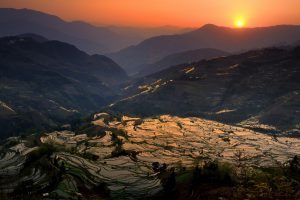
Yuanyang Rice Terraces has been a masterpiece of the ingenuity of the Hani people for generations. Southern Ailao Mountain, with this typical tiered landscape, is famed for its unique frontier scenery.
The Hani people’s ancestors came to this steep mountain area 2,500 years ago. In their struggle against the difficult terrain they successfully established the terraces, where they grew rice in order to make a living. The technology of developing fertile land on rugged mountain slopes didn’t spread all over China and Southeast Asia until 14th century. The creativity of the Hani people turned this mountain area into one of artistic beauty. In recognition, the Ming Dynasty (1368-1644) emperor granted the title of ‘Skillful Sculptor’ to Hani people and their good reputation was passed down from generation to generation. At present, known as ‘land sculpture’ the terraced fields have been being officially acknowledged by UNESCO as a World Cultural and Natural Heritage site.
Hani terraced fields are magnificent and on a large-scale. They extend to many towns along the south bank of the Red River, such as Yuanyang, Lüchun and Jinping among others. With an area of more than 113 square kilometers (28,005.3 acres), the terrace in Yuanyang County is regarded as the core area of Hani terraces as the county is mountainous and the terraces built on the hillsides have a slope varying from 15 degrees to 75 degrees. The terraces rise by 3,000 steps forming a landscape that is rare both at home and abroad. In the main, the Yuanyang Hani terraces form three major scenic areas: Duoyishu scenic area, Bada scenic area and Laohuzui (the Tiger Mouth) scenic area. So many terraces set among vast forests, topped by an ocean of clouds create a magical, magnificent view.
Main Rice Terraces in Yuanyang County
Duoyishu Rice Terraces (the Best Place to Take Pictures of the Sunrise)
Duoyishu Scenic Area is a 50-minute drive from Yuanyang. It is considered to be the best place to take pictures of the sunrise from the terraces. You are recommended to reach Duoyishu at dawn. As the sunlight appears on the horizon, it silhouettes the terraces and makes for an unforgettable moment. As the sun rises, the nearby village wakes up and people start walking on the ridge, presenting even more photo opportunities. When the sun rises over the mountain, everything is visible and clear, and the terraces glisten in the sunshine.
Bada Rice Terraces (the Best Place to Take Pictures of the Sunset)
Bada is the best place to get the sunset scenery of Yuanyang Rice Terraces. The terraces extend from the base to the top of the mountain, like ladders to heaven. As the sun sets, the terraces change colors incessantly; first they are pink, then turn to a rosy hue, and later to dark red.The spectacular sunset over Yuangyang Rice Terraces The spectacular sunset over the rice terraces. There are 17 Hani minority villages in this area. It is enjoyable to explore the villages and to see the traditional mushroom-shaped architectures of the Hani people.
Laohuzui Scenic Area (Rice Terraces Are More Rugged and Marvelous)
It is a 40-minute drive from Bada to Laohuzui. Laohuzui Scenic Area is situated in the core area of Yuangyang Rice Terraces. The 8.5 km2 (3.3 mi2) of rice terraces are more rugged and marvelous, looking like a natural picture painted by an artist.
Thousands of colorful layers extend for several kilometers and are dotted with trees. The best moment to enjoy the view of the marvelous rice terraces is during the sunset period.
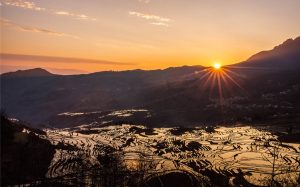
Major Scenic Sites
The Hani Terraces are distributed over the Yuanyang, Red River, Lvchun and Jinping counties, mainly grouped around Xinjie Town (New Street Town). The major scenic sites are listed as follows:
Xinjie Town (新街镇): It is 30 kilometers away from Nansha Town which now holds the government seat of Yuanyang County. It is about 1,500 meters above sea level. Standing on some roofs, one can take pictures and have a view of a sea of clouds, sunsets and villages. Most photography-lovers stay there and leave for other scenic sites by renting a vehicle.
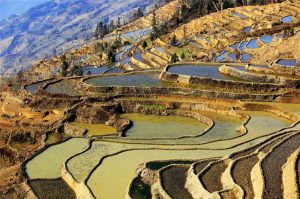
Qingkou (箐口): 8 kilometers away from Xinjie Town. Terraced fields can be seen everywhere in this site. Qingkou is a folk village, seated halfway down the hill. There are 150 families with more than 800 villagers. With the dense woods around it and the chorus of various kinds of birds, the original village represents the integrity of the ethnic culture of the Hani Terraces that comprises four elements: the forest, water, the terraces and the village. Walking along the flagged road, visitors can enjoy the masterpiece of the Hani Terraces culture. Visitors can enjoy the sight of farming and living facilities, such as the mushroom-shaped houses, Zhaishen wood, ditches, wooden cuts, water-powered roller for grinding grain, watermill, the building that houses the water-powered trip-hammer for husking rice, minority costumes, ploughs, harrows, hoes and looms.
In addition, two crystal springs named ‘White Dragon’ and ‘Longevity’ can be seen in the exhibition area.
Sheng Village (胜村): About 20 kilometers away from Xinjie Town. About half of the road to Xinjie is unpaved. There are some scenic spots nearby the country road, such as the Blue Dragon Teahouse, hills planted with tea, Beida village and Mali village. Mali village is also a typical Hani-type village with its special mushroom-shaped houses.
Sheng village is a great spot to see the Hani Terraces as well as a sea of clouds, and to enjoy local customs and practices. It is also a must-see place for photography.
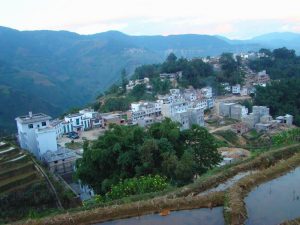
Habo Village (哈播): 85 kilometers away from Xinjie Town. It is on the southern side of Xinjie Town. It is a good place to take pictures of the rising sun but few photographers go there as it’s a long way to go.
Village Fair: Yuanyang is an area mainly inhabited by minority nationality people, such as Hani, Yi, Dai and Miao. Therefore, in addition to the terraces, photography-lovers can take pictures of folk customs of the local people. Village fairs held in the big villages may be good places to go, such as Sheng, Niujiao, Majie and Shatuola Panzhihua villages.
Nearby Attractions
Jianshui Ancient Town: It has unique folk houses and ethnic Hani customs.
Mengzi Ancient County: It is famous for a 100-year-old rail track and station, French-style houses, and Yunnan Rice Noodles.
The Stone Forest: Reputed as the “Stone Forest Museum”, it is the only karst stone forest in a subtropical plateau region in the world.
Yuanyang Hani Terraces Climate
Besides the seasons, weather is also a crucial factor for taking pictures. The Yuanyang Terraces are located at the southern part of the Ailao Mountains, the valley of Red River and Tengtiao River. It is said that there are about 180 days with foggy conditions each year because of its wet climate. Therefore, it is necessary to know the weather information before departure.

Best Seasons for Photographing
Generally speaking, there are two best seasons in a year.
The first one is the spring sowing season from January to March. Before planting, the water-filled rice terraces are like thousands of mirrors reflecting the blue sky, green hills and mountains, or the sunrise and sunset, presenting a marvelous view.
The second one is the autumn harvest season from July to September. At this time, the bottom of the Ailao Mountains is golden yellow with rice. Rice terraces with different harvest times show different colors, either deep or light.
Compared with the autumn harvest season, pictures taken in the spring sowing season may be better because the lines between the water in the terraces and the ridges of the fields are clear and beautiful.
The Best Times to Visit
The best time for appreciating Yuanyang Rice Terraces is from January to March, when the terraces have been irrigated and the water in the fields reflects the sunshine, creating many colors.
In early spring (from late February to March), the terraces are decorated with lots of flowers, including pink peach blossom and white pear blossom.
How to get to Yuanyang Rice Terraces
Yuanyang lies at an altitude ranging from 140 meters along the Red River up to nearly 3000 meters above sea level in the Alao Mountains. The road to Yuanyang is very steep and winding. At present, the only way to get to Yuanyang is by road (private car or long distance bus).
Private Car
To reach the final destination in Yuanyang – Yuanyang Rice Terraces, China Discovery suggests you use our private car service which can make everything easy for you. No matter you come from Kunming to Yuanyang or have a stop in Jianshui first and then get to Yuanyang, you’ll enjoy worry free transfer service with your own car. If you want to arrange the private service with private car or local travel guide, please feel free to contact our professional travel consultants.
Long Distance Bus
If you are independent travelers, you usually travel from Kunming to Yuanyang directly, or travel from Jianshui to Yuanyang. Both buses arrive at Yuanyang Nansha County and Yuanyang Xinjie County. The distance between Kunming and Yuanyang is about 375 kilometers. Travelers can take long distance buses from Kunming South Bus Station to Xinjie Town at 10:20, 13:30, 19:30 and 20:00. It takes about 7 hours. The distance between Jianshui and Yuanyang is about 141 kilometers. Travelers can take long distance buses from Jianshui Bus Station to Yuanyang Nansha Station during 07:15~18:40. It takes about 3~3.5 hours.
Recommended Tour Routes
The scenery of the terraced fields in Yuanyang is at its best from November to the following April. Taking a tour to Yuanyang Terraces in winter is amazing, since the fields are full of water, composing a colorful painting. We provide tourists with some tour routes to choose.
4 Days Long Street Banquet Festival and Yuanyang Rice Terraces Photography Tour
6 Days Kunming Shadian Muslim Tour with Yuanyang Rice Terraces and Jianshui Old Town
7 Days Yunnan Muslim Culture Tour with Shadian Mosque and Yuanyang Rice Terraces
Travel Tips
1. Yuanyang lies on the Tropic of Cancer, so the climate is neither extremely hot nor cold. However, it is cooler in morning and evening, and the sun is very strong at noon. You should pay attention to sun protection. Moreover, T-shirts and shorts can be worn all year round, but you are advised to take a jacket.
2. It is very interesting to participate in a local country fair, during which the entire minority people dress in colorful ethnic costumes. It is very lively.
Introduction
Laohuzui(Tiger Mouth)Rice Terraces scenic area mainly consists of Mengpin Village, Dongfu Village, Amengkong Village, Baoshan Village and etc. It got the name due to its shape. The zigzag highway traverses the cliff of the mountainside, and beats away a breach at one corner, which presents an image of tiger mouth.
With the precipitous gradient and the grandest layout, the Terraces are featured by the strong gradation and the wonderful color. Between two mountains is the whole valley and the gradient is above 70 degrees. Under the villages are green hills and trees, running water and villages. Layers of terraces vertically drop into river valley, which is pretty grand.
What’s more, it is the best place to enjoy natural landscape, manners and customs of of Yi people.
Why Visit Laohuzui Rice Terraces?
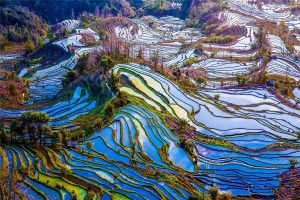
Laohuzui Rice Terraces, also called Tiger Month Rice Terraces or Mengpin Rice Terraces, is core area of Cultural Landscape of Honghe Hani Rice Terraces, the 45th World Heritage Site of China which announced by UNESCO in 2013.
With an area of 460 hectare, Laohuzui Rice Terraces consists of Mengpin Village, Dongfu Village, Baoshanzhai Village, Amengkong Village, etc. It is the steepest, the grandest, the most magnificent Rice Terrace among all the rice terraces of Yuanyang. Besides, it has strong layering, three-dimensional sense, contrast color, making Laohuzui Rice Terrace a beautiful Chinese painting. Laohuzui Rice Terraces is the best site for SUNSET.
Recent news: Due to the collapse caused by the sudden mud-rock flow and heavy rain in Yuanyang, the Tiger Mouth Rice Terraces is temporarily closed. At present, Duoyishu scenic area and Bada scenic area are still opening to the public. We will update the news once we get the official notice of the reopening of the Tiger Mouth Rice Terraces.
Main Attractions in Laohuzui Rice Terraces
Mengpin Village (勐品村)
Mengpin Village is in a mountain area. Planting, cultivation and tourism are characteristic industries there. Natural beauty, rural custom and terraces make there a fantastic picture.
Amengkong Village (阿勐控)
Looking to the west, you will see three mountains of backbone in which more than 2000 mu terraces of Amengkong stretch from the South to the West. Suddenly high or low, suddenly big or small, suddenly bending or straightening, terraces are like big dragons waving in the sunset.
Baoshan Village (保山寨)
Terraces of Baoshan Village has one of the best beauties of lines, figures and stereoscopy.
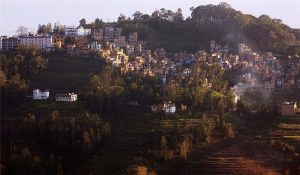
Laohuzui Rice Terraces Sunset
Many photographers said that Laohuzui Rice Terraces has the most magnificent rural scenery. So, many travelers from home and abroad head to the remote Yuanyang for the most spectacular rice terrace scenery.
Standing on the top of Laohuzui Rice Terraces, travelers can have panoramic view of the rice paddies which presents you a blooming white flower in front of you. When the sun goes down and the light gets dim, the whole rice terraces is turning into blue as clear and bright as mirrors, and then turning into golden. When the sunglow shows, the rice paddies is turning into pink, rosy, dark red…Different color changes in a very short time and Laohuzui Rice Terraces shows you amazing rice paddies like magic.
Best Spot to View & Shoot Sunset
Viewing Decks
There are two viewing decks of Laohuzui Rice Terraces, one is located at a higher location near the road and one is located in the middle of the hill. Travelers standing at the higher viewing deck can have panoramic view of the whole Laohuzui Rice Terraces and travelers getting down to the lower viewing deck can shoot the essence of Loahuzui – sometimes like two horses galloping quickly, sometimes like millions of snakes wriggling, sometimes like a white flower blooming…
The sun goes down during 18:00~20:00 in Laohuzui Rice Terraces. In the spring time (March to May), it is usually during 19:10~19:50, in summer (June to August) at 19:25~19:57, in autumn (September to November) at 18:20~19:26 and in winter (December to February) at 18:20~19:11. If you are professional photographers, you’d better get to Bada Rice Terraces before 16:00 to find a good location (lower viewing deck is recommended) for some great pictures with rice terraces, sea of clouds and sunset.
The Best Time to Visit Laohuzui Rice Terraces
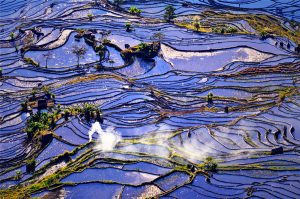
The best moment to enjoy the marvelous rice terraces view is the sunset period. In addition, the sunrise and cloud sea in Laohuzui are also very beautiful.
From November to April, the terraces are in irrigation period. Most amazing pictures on the Internet are shooted at that time. In May, the Laohuzui rice fields turn into green from yellow, right after the farmers did the rice seedlings at the end of spring.
Location & Transportation
Laohuzui Rice Terraces is about 20 kilometers from Xinjie Town (the old town of Yuanyang), 50 kilometers from Nansha Town (the new town of Yuanyang) and about 375 kilometers from Kunming, the capital of Yunnan Province. To reach Laohuzui Rice Terraces, travelers can take long distance buses to Xinjie Town or Nansha Town first and then take local minibus to this rice terraces.
Distances from Other Scenic Spots of Yuanyang
● About 5 kilometers from Bada Rice Terrace
● About 7.2 kilometers from Duoyishu Rice Terrace
● About 4.8 kilometers from Jingkou Folk Village
How to Get there?
Kunming to Yuanyang: From Kunming South Bus Station, there are direct long distance buses to Yuanyang Xinjie Town, running schedules around 10:20, 13:30, 19:30 and 20:00. There are buses at 09:05, 12:30 and 18:30 from Yuanyang Xinjie Town to Kunming. It takes about 7 hours between Kunming and Yuanyang.
Nansha Town/Xinjie Town to Bada Rice Terraces: Travelers may take long distance buses to Nansha Town or Xinjie Town from Kunming, Jianshui, and no matter which station you arrive at, travelers can take local minibus to Laohuzui Rice Terraces. It takes about 1 hour from Nansha Town to Xinjie Town and 30 minutes from Xinjie Town to Laohuzui Rice Terraces. (Please Note: It is recommended to use our private car service to reach several rice terraces including Laohuzui Rice Terrace. If you are an independent traveler, you can try to hire a local minibus to cover all the highlighted rice terraces in one day which costs around 300 Yuan per day.)
Recommended Visiting Routes
It is better to arrange two or three hours to visit Laohuzui Rice Terraces. We provide tourists with some tour routes to choose.
1. Kunming-Yuanyang(Xinjie Town)-Laohuzhui Rice Terraces
Kunming South Passenger Station: departing for Yuanyang, Xinjie Twon, at 10:20/12:30/19:00 every day, CNY 139 per, lasting 5 to 6 hours. Then you can rent a car to reach Laohuzui Rice Terraces, CNY 5~10 yuan per.
Take a chartered car: CNY 300 a day to visit around Yuanyang Rice Terraces, and about CNY 100 to get to Laohuzui Rice Terraces.
2. Kunming-Nansa County-Xinjie Town-Laohuzhui Rice Terraces
Take the regular bus from Kunming to Nansha county, then take the mini bus to Xinjie town(CNY 10 per, departing from 7:00~20:00). From Xinjie town to the entrance of the Yuanyang Hani Rice Terraces or from the entrance to each scenic spot, you can rent a car to go, CNY 5~10 per.
3. Kunming – Jianshui/Gejiu – Yuanyang
Kunming East Passenger Station: leaving for Jianshui or Gejiu and costing CNY 85 per and 3 or 4 hours and a half. And train from Kunming to Jianshui is also available. Then you can take a regular bus to Yuanyang, CNY 16-32 per.
Other Tour Routes
1 Day Yuanyang Hani Rice Terraces Hiking Tour from Duoyishu to Laohuzui
6 Days Kunming Yuanyang Jianshui Photography Tour with Honghe Hani Rice Terraces
10 Days Southeast Yunnan Family Tour with Ethnic Culture, Rice Terraces, Mushroom House & Butterfly Valley
Travel Tips
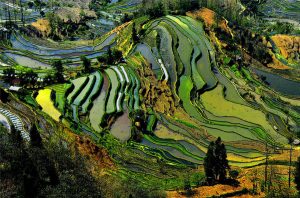
1. Hani Ethnic Festivals & Traditions
Hani people would celebrate some traditional festivals, like Hani New Year, Kuzhazha Festival, etc.
Hani New Year is like the Spring Festival of Han. It takes place in the first Dragon Day of the 10th lunar month each year and lasts 5 to 6 days and even as long as 13 days. Every family would prepare chicken, pork to worship their ancestors and family members gather together to enjoy the union. In the last day of the New Year, a Long Table Banquet will be arranged and tables will be laid in the street which can extend to one kilometer long. Each family will serve the most sumptuous dishes to fill up a table and enjoy the banquet together.
Kuzhazha Festival takes place from lunar June 23 to 26 and every family makes sticky rice, sets the feast, makes fresh rice and worships the ancestor.
2. Tickets
Ticket One: It is valid for 3 days. It is 100 Yuan for per person, including four scenic spots Jingkou Folk Village, Bada Rice Terraces, Duoyishu Rice Terraces and Laohuzui Rice Terraces (Tiger Mouth Rice Terraces).
Ticket Two: It is valid for 10 days. It is 180 Yuan for per person, including four scenic spots Jingkou Folk Village, Bada Rice Terraces, Duoyishu Rice Terraces and Laohuzui Rice Terraces (Tiger Mouth Rice Terraces).
Ticket Three: It belongs to annual ticket which is valid for one year. It is about 360 Yuan per person, including four scenic spots Jingkou Folk Village, Bada Rice Terraces, Duoyishu Rice Terraces and Laohuzui Rice Terraces (Tiger Mouth Rice Terraces).
3. Accommodation
There is one 3-star hotel called Yuanyang Yunti Hotel in Xinjie Town and travelers are recommended to spend your night there. Besides, there are many hostels in Xinjie Town and other scenic areas and if you want to find a hostel with basic facilities close to the scenic area, you’ve got a lot of choice.
4. Two Spots to Shoot Sunset
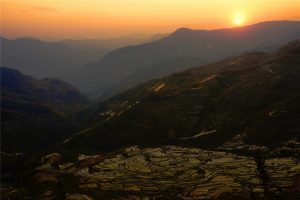
Laohuzui Rice Terraces has two viewing areas, one high up near the access road that has recently been enclosed by a 200-meter fence. The upper area is easy to become a noisy traffic jam before sunset, when tour buses, private cars and trucks clog the narrow road outside the other upper viewing area.
No matter which platform you choose, it is advisable to show up for at least an hour before sunset to get a good spot. There is also a lower area that can be reached after walking down a set of switchbacks. You may want to skip the lower platform if you have bad knees as the climb back up is fairly strenuous.
Other Travel tips
The visitors usually set off to Laohuzui Rice Terraces after 4:30 pm, you can check out the time of sunset on the Internet or ask the local people.
The weather forecast of Yuanyang on the Internet may be not exact because the weather of the rice terraces area is always changeable and unpredictable.
The temperature here varies greatly between day and night. Please pay attention to keep warm especially in early morning or at night.
Why Visit Bada Rice Terraces?
Bada Rice Terraces, a part of Honghe Hani Rice Terraces, was listed as World Heritage Site in 2013. The 950-hectare Bada Rice Terraces is like the ladders to the heaven with over 3700 levels, rising up from 800 meters to 2000 meters. Hence, the words “Vast”, “Magnificent”, “Beautiful Curved Lines” and “Stereoscopic” can be used to describe Bada Rice Terraces. There are some villages including Quanfuzhuang, Malizhai, Bada, Shangmadian surrounded by the rice terraces and travelers can have panoramic view of the beautiful villages when shooting the rice paddies.
Introduction of Bada Rice Terraces
Bada Rice Terraces Scenic Area is a bright pearl in the tourism of Yuanyang, which includes Quanfuzhuang Rice Terraces, Malizhai Rice Terraces, Bada Rice Terraces and Shangmadian Rice Terraces. There, what you can enjoy is the natural landscape, humanities and ethnic flavor of Hani people since thousands of them have been living there generation after generation.
It is the best place to entertain the spectacular scenery with stereoscopic and curved line, and also the great attraction to have a profound knowledge, analyses and understanding of the Hani culture. With over 3700 levels, endless terraces are like ladders up to the heaven, rising up from the 800 meters of Malizhai River to 2000 meters of the summit of the mountain. Glittering and shimmering, under the sun, the Terraces are just like a mysterious wonderland.
Bada Rice Terraces Magnificent Sunset (Highlights)
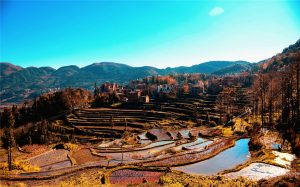
The words “Magnificent”, “Spectacular”, “Grand” cannot express “Bada Rice Terraces” fully. At the dusk, when the sun shines on the 950 hectares rice paddies rising from 800 meters to 2000 meters, the magnificent scene forms, like the latters toward heaven. In the winter time after autumn harvest, the rice terraces are filled with water and when sunset glow shines upon the paddies, the 3700 level terraces first turns pink, then rosy and later dark red, pink, golden and white….The sea of clouds over Bada Rice Terraces add more mysterious feel and when standing on the top of the rice paddies and looking down and around, you only have to say “This is the most spectacular rice paddies I have ever seen”. That’s the magic of Bada Rice Terraces.
Best Spot to View & Shoot Sunset
Viewing Decks
Bada Rice Terraces has two viewing decks that offer views at similar heights but different lateral perspectives. One viewing platform faces the sun directly and when you take pictures of the rice paddies, the ridges of the rice terraces line in vertical scene. While, the other viewing platform offers side view of the spectacular rice paddies. There is a footpath from the first viewing deck leading to the second viewing deck. Travelers or photographers can try both locations to photograph amazing pictures.
The sun goes down during 18:00~20:00. In the spring time (March to May), it is usually during 19:10~19:50, in summer (June to August) at 19:25~19:57, in autumn (September to November) at 18:20~19:26 and in winter (December to February) at 18:20~19:11. If you are professional photographers, you’d better get to Bada Rice Terraces at 16:00 and find a good location for some great pictures with rice terraces, sea of clouds, Hani villages and sunset.
Best Time to Visit Bada Rice Terraces
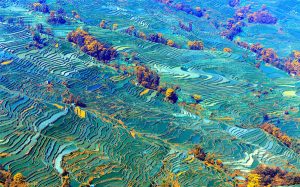
Travelers can come all the year round and for photographers, the best time is from November to March of next year.
Dusk: At dusk, it’s best to appreciate Bada Rice Terraces. When the sun shines on the rice paddies of 950 hectares from 800 meters to 2000 meters, the amazing view may shock or thrill you.
Winter: Visiting Bada Rice Terraces in winter is definitely a perfect trip. The rice terraces are full of water after autumn harvest; when sunset glows softly upon the paddies, the terraces first turns pink, then rosy and later dark red, pink, golden and white at length.
Location & Transportation
Bada Rice Terraces is about 16 kilometers from Xinjie Town (the old town), 46 kilometers from Nansha Town (the new town) and about 375 kilometers from Kunming, the capital of Yunnan Province. Travelers can take bus from Kunming to Yuanyang Xinjie Town or Nansha Town first and then transfer to Bada Rice Terrace from Xinjie Town by local minibus.
Distances from Other Scenic Spots of Yuanyang
● About 5 kilometers from Laohuzui Rice Terrace
● About 2.7 kilometers from Duoyishu Rice Terrace
● About 2.5 kilometers from Jingkou Folk Village
How to Get there?
Kunming to Yuanyang: From Kunming South Bus Station, there are direct long distance buses to Yuanyang Xinjie Town, running schedules around 10:20, 13:30, 19:30 and 20:00. There are buses at 09:05, 12:30 and 18:30 from Yuanyang Xinjie Town to Kunming. It takes about 7 hours between Kunming and Yuanyang.
Nansha Town/Xinjie Town to Bada Rice Terraces: Travelers may take long distance buses to Nansha Town or Xinjie Town from Kunming, Jianshui, and no matter which station you arrive at, travelers can take local minibus to Bada Rice Terraces. It takes about 1 hour from Nansha Town to Xinjie Town and 20 minutes from Xinjie Town to Bada Rice Terraces.
Recommended Visiting Routes
It is better to arrange two or three hours to visit Bada Rice Terraces, we provides tourists with some tour routes to choose.
1. Kunming-Yuanyang(Xinjie Town)-Bada Rice Terraces
Kunming South Passenger Station: departing for Yuanyang, Xinjie Twon, at 10:20/12:30/19:00 every day, CNY 139 per, lasting 5 to 6 hours. Then you can rent a car to reach Laohuzui Rice Terraces, CNY 5~10 yuan per.
Take a chartered car: CNY 300 a day to visit around Yuanyang Rice Terraces, and about CNY 100 to get to Laohuzui Rice Terraces.
2. Kunming-Nansa County-Xinjie Town-Bada Rice Terraces
Take the regular bus from Kunming to Nansha county, then take the mini bus to Xinjie town(CNY 10 per, departing from 7:00~20:00). From Xinjie town to the entrance of the Yuanyang Hani Rice Terraces or from the entrance to each scenic spot, you can rent a car to go, CNY 5~10 per.
3. Kunming – Jianshui/Gejiu – Yuanyang
Kunming East Passenger Station: leaving for Jianshui or Gejiu and costing CNY 85 per and 3 or 4 hours and a half. And train from Kunming to Jianshui is also available. Then you can take a regular bus to Yuanyang, CNY 16-32 per.
Other Tour Routes
1 Day Yuanyang Bada Hani Rice Terraces Hiking Tour
6 Days XishuangBanna Tea Mountain Hiking Tour to Bada, Zhanglang, Xiding and Nannuo Tea Mountain
Travel Tips
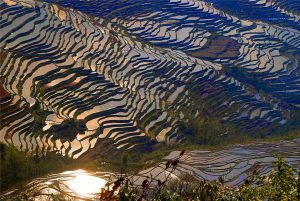
1. Two Spots to Shoot Sunset
Bada Rice Terraces has two viewing decks that offer views at similar heights but different lateral perspectives. One viewing platform is faced with the sun directly so when you take photos of the rice paddies, the ridges of the rice terraces are in vertical scene. The other platform displays the side view of paddies. Between two viewing decks, there is a footpath. Either of them is a good choice for photographers.
2. Hani Ethnic Festivals & Traditions
Hani people would celebrate some traditional festivals, like Hani New Year, Kuzhazha Festival, etc.
Hani New Year is like the Spring Festival of Han. It takes place in the first Dragon Day of the 10th lunar month each year and lasts 5 to 6 days and even as long as 13 days. Every family would prepare chicken, pork to worship their ancestors and family members gather together to enjoy the union. In the last day of the New Year, a Long Table Banquet will be arranged and tables will be laid in the street which can extend to one kilometer long. Each family will serve the most sumptuous dishes to fill up a table and enjoy the banquet together.
Kuzhazha Festival takes place from lunar June 23 to 26 and every family makes sticky rice, sets the feast, makes fresh rice and worships the ancestor.
3. Tickets
Ticket One: It is valid for 3 days. It is 100 Yuan for per person, including four scenic spots Jingkou Folk Village, Bada Rice Terraces, Duoyishu Rice Terraces and Laohuzui Rice Terraces (Tiger Mouth Rice Terraces).
Ticket Two: It is valid for 10 days. It is 180 Yuan for per person, including four scenic spots Jingkou Folk Village, Bada Rice Terraces, Duoyishu Rice Terraces and Laohuzui Rice Terraces (Tiger Mouth Rice Terraces).
Ticket Three: It belongs to annual ticket which is valid for one year. It is about 360 Yuan per person, including four scenic spots Jingkou Folk Village, Bada Rice Terraces, Duoyishu Rice Terraces and Laohuzui Rice Terraces (Tiger Mouth Rice Terraces).
4. Accommodation
There is one 3-star hotel called Yuanyang Yunti Hotel in Xinjie Town and travelers are recommended to spend your night there. Besides, there are many hostels in Xinjie Town and other scenic areas and if you want to find a hostel with basic facilities close to the scenic area, you’ve got a lot of choice.
5. Others travel tips
The weather forecast of Yuanyang on the Internet may be not exact because the weather of the rice terraces area is always changeable and unpredictable.
The temperature here varies greatly between day and night. Please pay attention to keep warm especially in early morning and at night.
Introduction
Walk from Yuanyang Xinjie Town into Yuanyang Terraced Fields, Qingkou Rice Terraces is at the first sight. The viewing deck of Qingkou Rice Terraces is by the highway. It covers an area of almost 10000mu. The field is just like a sea with twinkling water ripples and it changes all the time. The fields descend down layer by layer. The ridges of the fields show a exquisite outlines of the fields with large-scale red duckweed which makes the fields colorful. The beauty of the terraces are beyond words.
Forest, streams, Villages and terraces are what Hani people cherish. They till the land not to conquer the nature but to accept the “gift” given by God and strike for the harmony of human and nature. Thus, they can create the masterpiece- terraces.
Tranditional & Ethnic Village
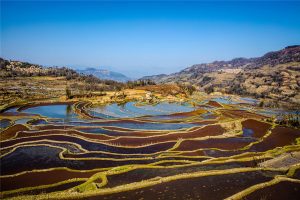
Qingkou is a typical Hani Village, which consists of 150 families and has a population of 800 of Hani ethnic minority.This Hani village is mainly presents the common characteristics of the Hani Terraced Fields culture. It maintain an integrated ecosystem among the forest, water system, villages and terraced field. Having been properly exploiting and comprehensively using the natural resources for hundreds of years, it is regarded as a model village in promoting the agricultural development. It not only protects its ecological balance but also promotes its development and civilization. There is also a museum established to showcase the history and culture of Hani people.
The village is shrouded in luxuriant forests where you can here the humming birds and cicadas in summer and experience the primitiveness.Walking around the village along the stone path, you can see the change of time as well as the local unchanged life on magnificent terrace fields. The earth-made houses on the both side of path are well ranked, whose housetop looks like a big mushroom. These houses are called mushroom houses, which are the traditional residences of Hani people. They are comprised of earth-made walls, bamboo or wood frameworks and straw housetops.
The Best Time to Visit Qingkou Hani Rice Terraces
The best moment to enjoy the marvelous rice terraces view is the sunset period. In addition, the sunrise and cloud sea in Laohuzui are also very beautiful.
From November to April, the terraces are in irrigation period. Most amazing pictures on the Internet are shooted at that time. In May, the rice fields turn into green from yellow, right after the farmers did the rice seedlings at the end of spring.
How to Get there?
1. You can take the regular bus from Kunming to Yuanyang in Kunming South Passenger Station at 10:20/12:30/19:00 every day, CNY 139 per, lasting 5 to 6 hours.
2. You can take the regular bus from Kunming to Nansha county then take the mini bus to Xinjie town(CNY 10 per, departing from 7:00~20:00). From Xinjie town to the entrance of the Yuanyang Hani Rice Terraces or from the entrance to each scenic spot, you can rent a car to go, CNY 5~10 yuan per.
3. Or you can choose another route to get to Yuanyang: Kunming – Jianshui/Gejiu – Yuanyang.
Recommended Visiting Routes
It is better to arrange two or three hours to visit Rice Terraces. We provide tourists with some tour routes to choose.
3 Days Jianshui and Yuanyang Hani Rice Terraces Group Tour
6 Days Kunming Yuanyang Jianshui Photography Tour with Honghe Hani Rice Terraces
8 Days Yunnan Photography Tour with Dongchuan Red Land and Yuanyang Hani Rice Terraces
Travel Tips
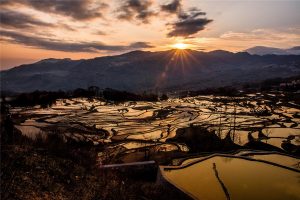
Ticket
• The day ticket is CNY 100 (including Duoyishu, Bada, Laohuzui Scenic Areas and Jingkou Folk village).
• The through ticket is CNY 180 ( you can visit the above four scenic areas in ten days of validity).
• The annual ticket is CNY 360 ( you can visit the above four scenic areas in one year of validity).
Accommodation:
There are many hostels in Xinjie Town. If you arrange your accommodation in Xinjie Town, you should take a mini bus to arrive at each scenic area. Apart from Xinjie town, you can also stay at Duoyishu Rice Terraces Scenic Area and Shengcun Village where various hostels and inns are located. The hostel are decorated in Hani ethnic style and offer great chance to view the beautiful rice terraces through windows.
Other Travel tips
The visitors usually set off to Laohuzui Rice Terraces after 4:30 pm, you can check out the time of sunset on the Internet or ask the local people.
The weather forecast of Yuanyang on the Internet may be not exact because the weather of the rice terraces area is always changeable and unpredictable.
The temperature here varies greatly between day and night. Please pay attention to keep warm especially in early morning or at night.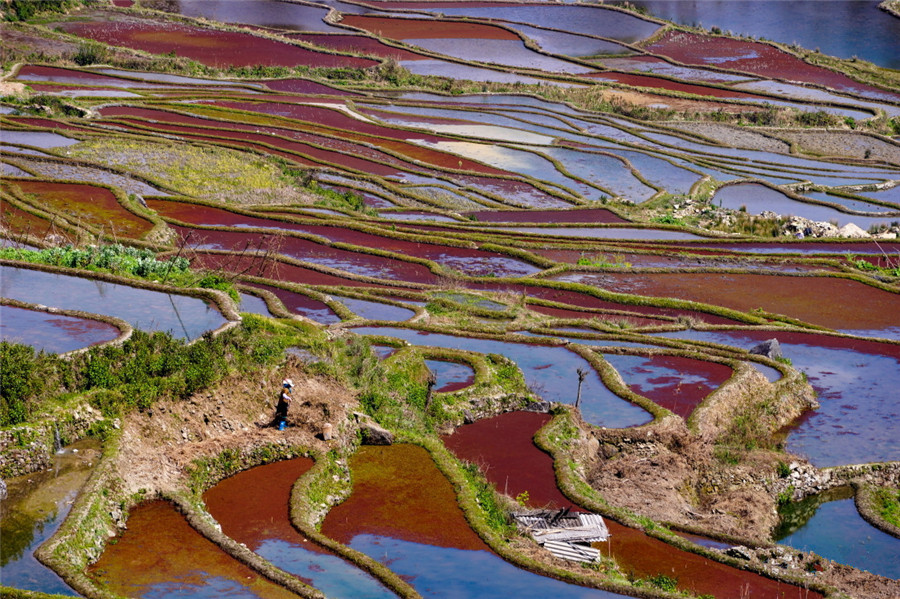

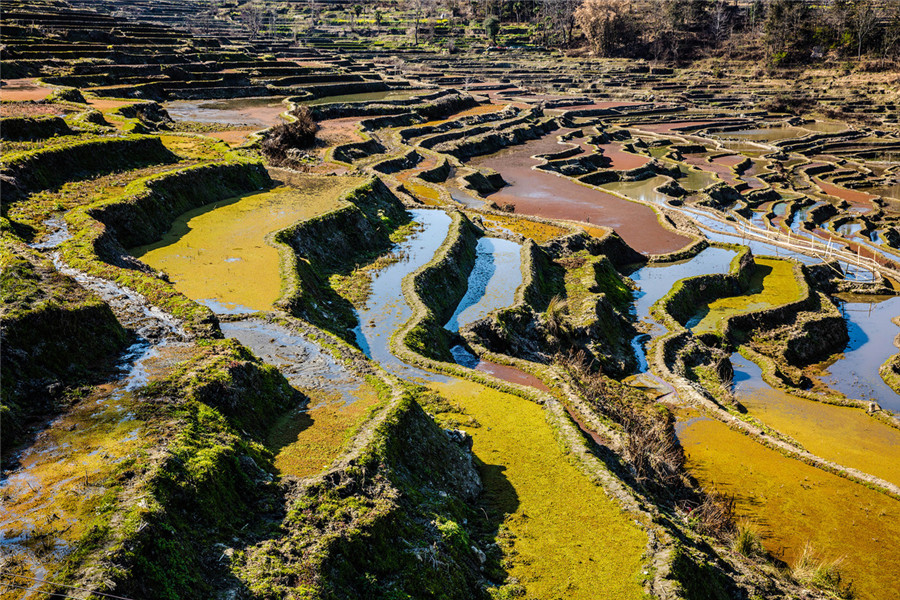
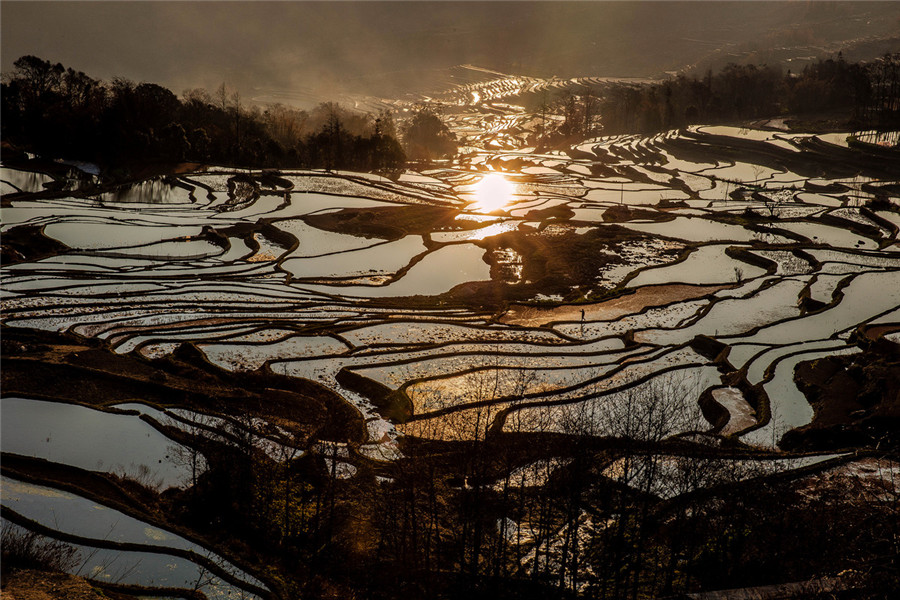
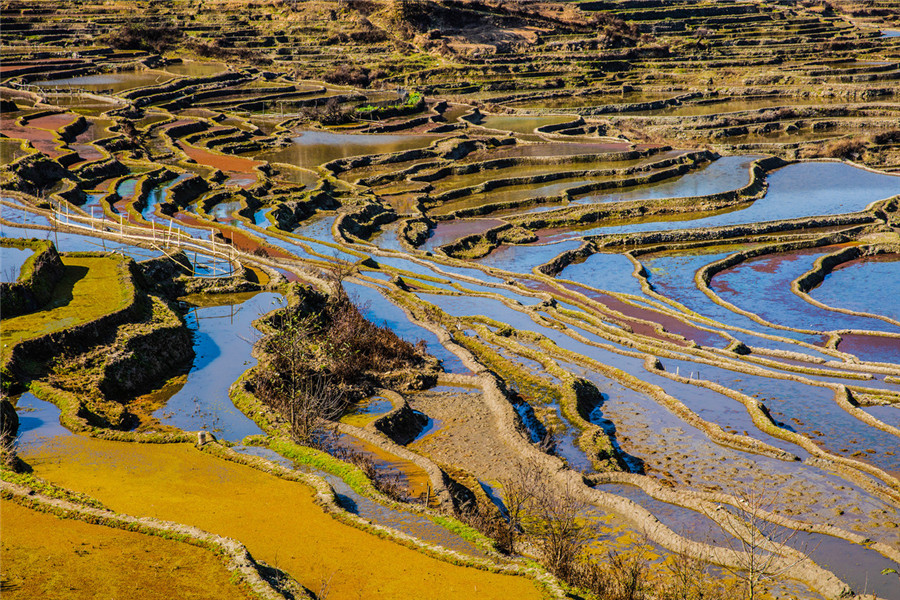
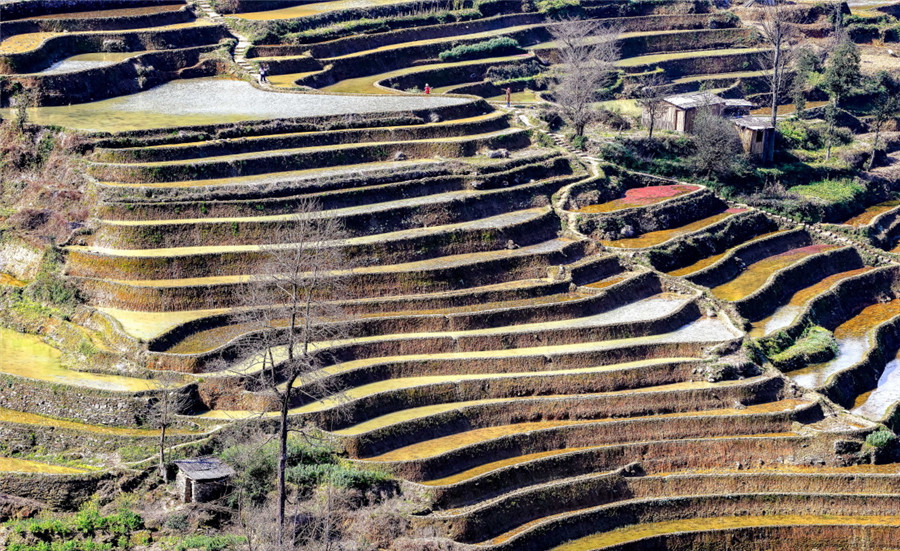
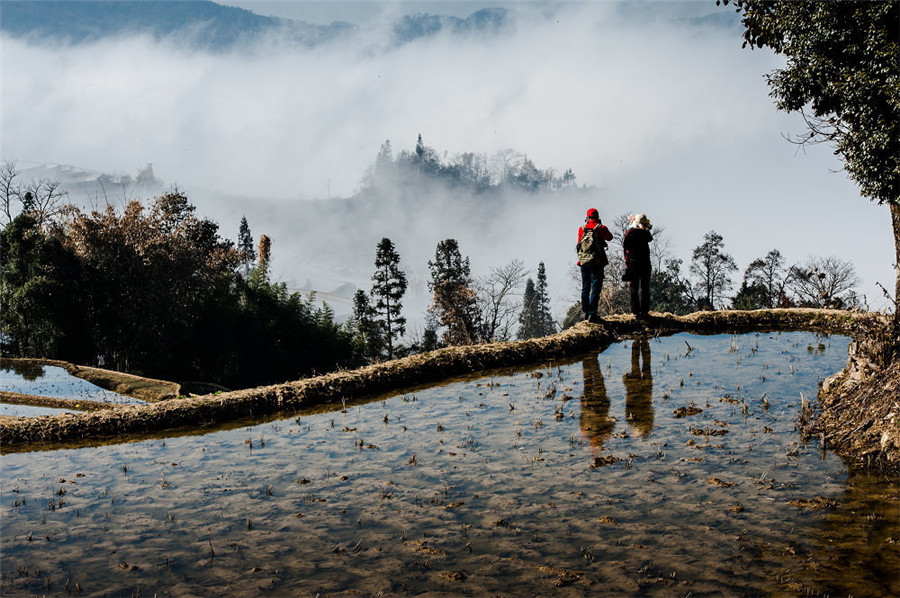



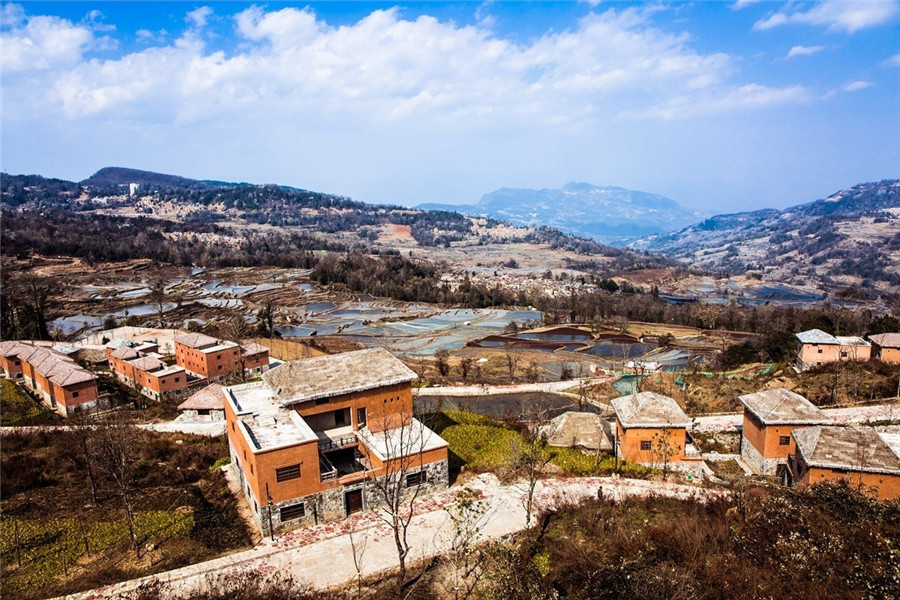
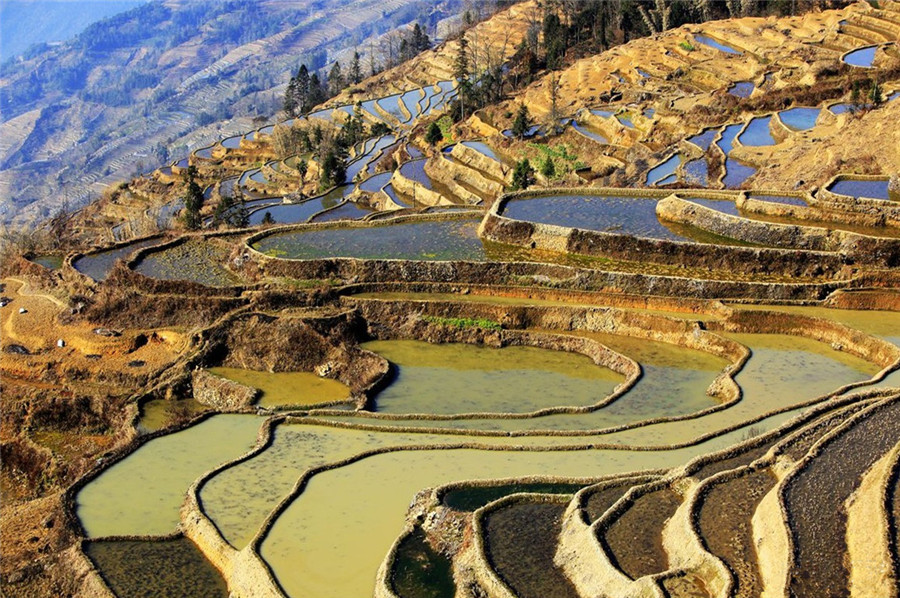
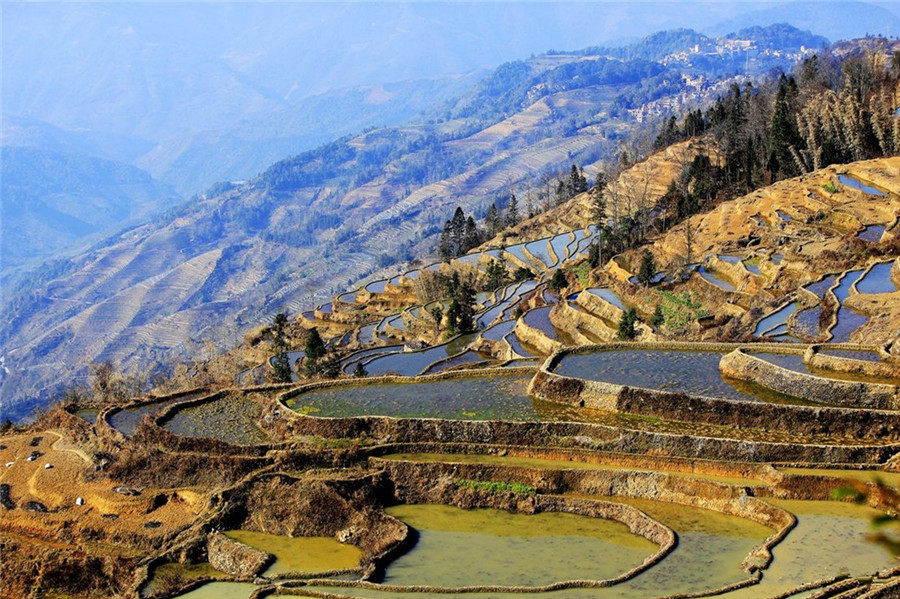

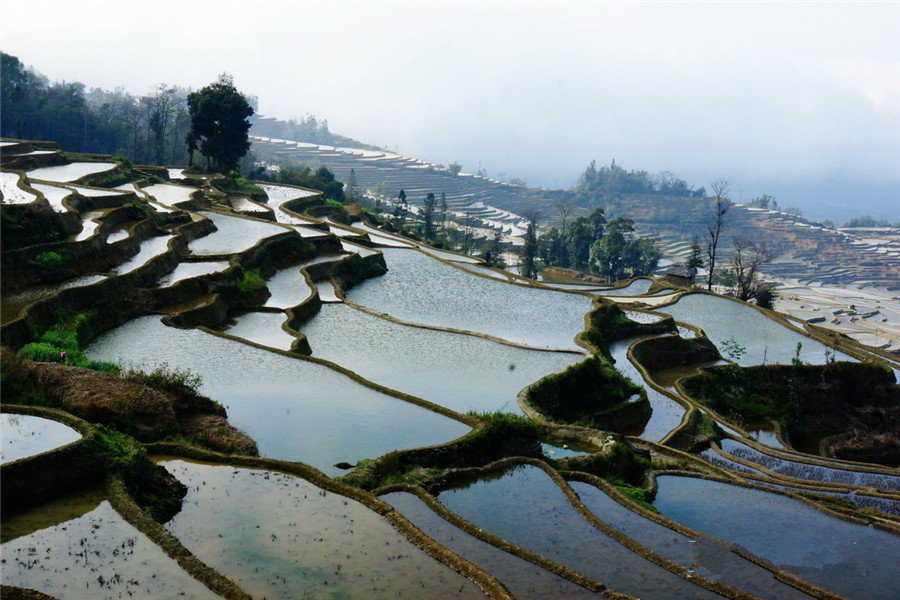

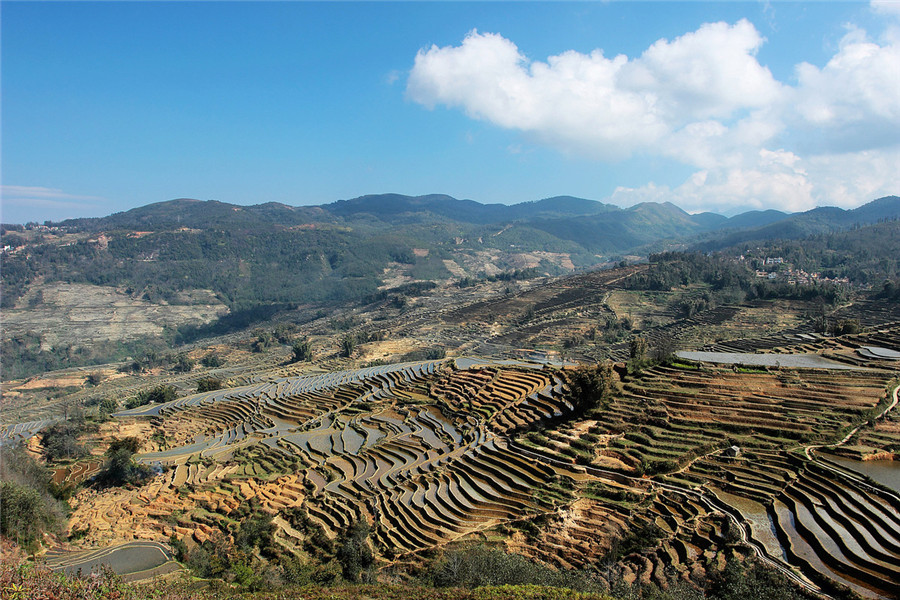
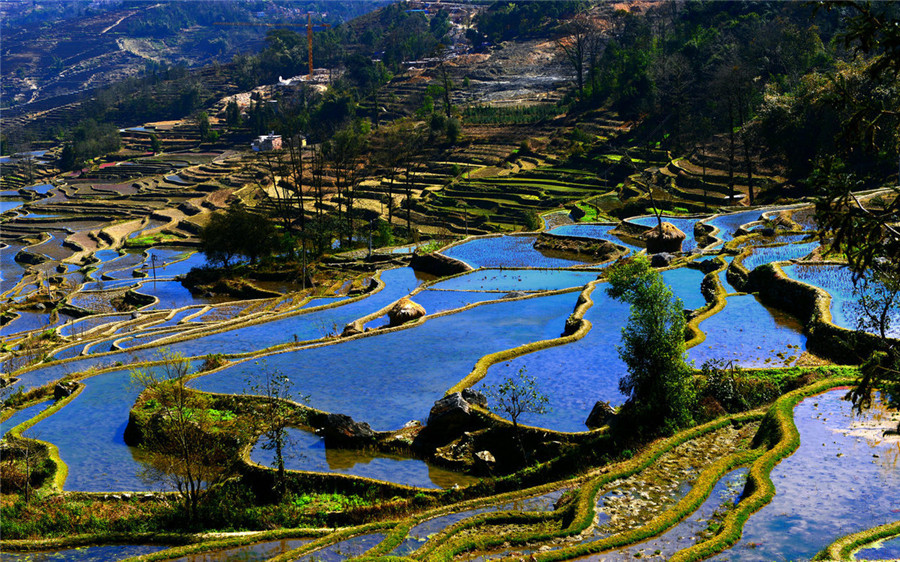
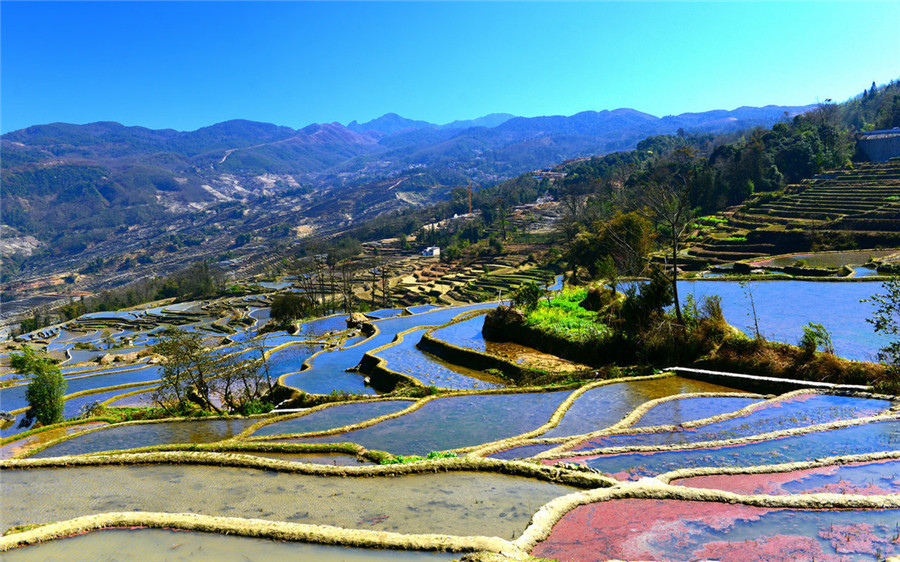
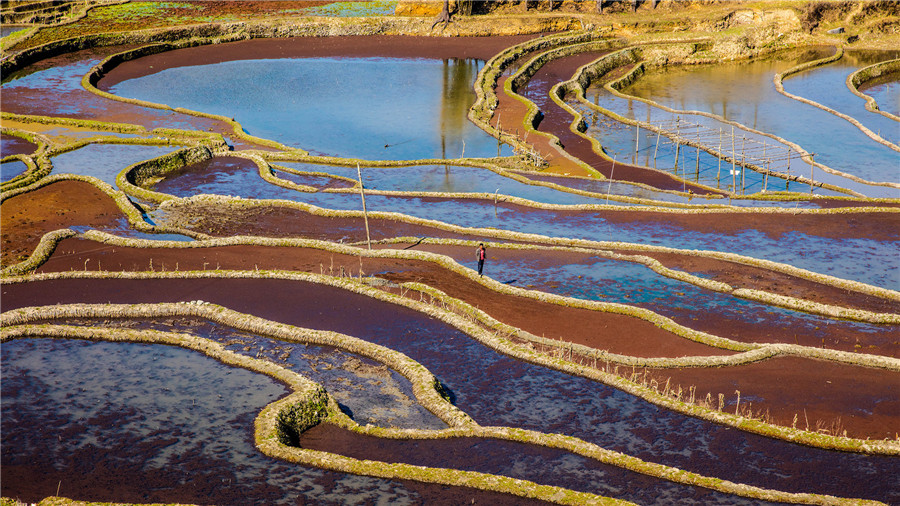
Why Visit Duoyishu Rice Terraces?
Duoyishu Rice Terraces, part of Honghe Hani Rice Terraces, was listed as World Heritage Site in 2013. This scenic area is the best site to watch sunrise over the vast rice paddies, sea of clouds and enjoy harmonious Hani folk life.
There is a ballad going in Yuanyang “If you travel to Yunnan, you should go to Yuanyang for the rice terrace together with the sea of clouds make it a mysterious wonderland”. If you come to Yuanyang, you should never miss Duoyishu Rice Terraces for the amazing sunrise which makes you never want to leave. Duoyishu Rice Terraces, part of Honghe Rice Terraces, was listed as World Heritage Site by UNESCO in 2013. It is marked by spectacular terraces that cascade down the slopes of towering Aliao Mountain to the banks of the Hong River. Over the past 1300 years, the Hani people have developed a complex system of channels to bring water from the forested mountaintops to terraces. The rice terraces is a testimonial to demonstrate extraordinary harmony between Hani people and their environment, both visually and ecologically.
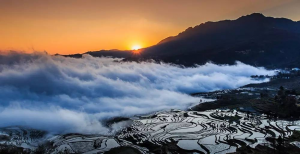
Duoyishu Rice Terraces scenic area has 400 hectare which is composed of Huangcaoling, Duoyishu, Aichun, Dawazhe, etc. When the sun rises over the surrounded mountains, the rice terraces change its color into golden, shining brilliantly. The mysterious sea of clouds, special mushroom houses and beautiful rice paddies and working Hani people are very harmony.
Introduction
Duoyishu Rice Terraces Scenic Area got its name from the local Duoyi, a beautiful place inhabited by Hani people. It is composed of Duoyishu Rice Terraces, Huangcaoling Rice Terraces, Aichun Rice Terraces and Pugaolao Village, etc. The altitude of Duoyishu Village is over 1,700 meters. The 9,700 acres’ of terraces below the village is the best spot to watch the sunrise.
Early in the morning, when the bright sun comes up to the top of the mountain, sunglow lights half of the sky, and then the full mountain of terraces are glittering. It seems that the mountain is wearing such a colorful dress that it dazzles people’s eyes.
The terraces here are always lost in the cloud and mist. The sea of clouds appears hither and thither and varies quickly. It is over the high mountain and on the next moment, it suddenly disappears without a trace. In the process of waiting, you will marvel at the extremely wonderful scenery and natural masterpiece, and you will be thrilled at the hard work of generations of Hani people.
Duoyishu Rice Terraces Amazing Sunrise (Highlight)

Duoyishu Rice Terraces is the best site to watch sunrise over the rice fields. In the early morning, the sunglow appears splendidly over the mountains and just a few minutes later, the gentle sun begins to show up and rise slowly over the top of the mountains. When the sun rises up the 6000-mu Duoyishu Rice Terraces, the whole villages turns bright and the vast rice terraces look like a mirror, radiating the rays of golden light. What makes Duoyishu sunrise the most beautiful is not only the golden rice terraces, but also the mysterious sea of cloud and Hani people’s mushroom-like houses. No matter you are photographers or not, catch the best moment to keep the amazing Duoyishu Rice Terrace sunrise with your camera.
Best Spot to View & Shoot Sunrise
Viewing Decks
There are two view decks of Duoyishu Rice Terraces, one is located on the top of the Pugao Old Village, close to the Duoyishu Ticket Booth and the other one is located in Pugao Old Village, very close to the rice terraces. It is suggested that use the higher viewing deck to watch the sun rises over the mountain and photograph the brilliant rice terrace scene. And if you have more time, you can take a walk down to the village and reach the lower deck to catch more beautiful scenery. From the lower deck, travelers can hike down the paddy rice terraces and have more memorable time in the mysterious village.
The sun rises up during 06:00~07:30 and usually around 07:00 in the spring time. If you are professional photographers, you’d better get up at 05:00 and arrive at the viewing decks around 05:30 to find a good location. Otherwise, travelers can come around 06:30.

Photography Suggestions
To capture the magnificent Duoyishu Rice Terrace, it is good to use wide angle (14mm~24mm, 17mm~35mm) and telephoto lenses (70mm~200mm or above). A tripod and lens hood will make your pictures perfect when shooting sunrise over the rice paddies. Also, polarizer and gradual change grey color lenses will help you get better terrace pictures. The weather of Duoyishu changes a lot and it is good to take waterproofing and damp proofing measure. And you’d better ask more advice from your photography guide.
Best Time to Visit Duoyishu Rice Terraces
November to Next April: The best season to visit is from November to next April because the terraces are in irrigation period at that time. Both season has its own charm in Duoyishu Rice Terraces. In spring, local Hani people and cattle are working in the fields, and the whole terraces turn into green. In summer, the sea of clouds over the rice terraces is changeable but more charming.
Recommended Visiting Routes
It is better to arrange 2 or 3 hours to visit Duoyishu Rice Terraces, we provide tourists with some tour routes to choose.
1. Nansha Town/Xinjie Town to Duoyishu Rice Terraces: Travelers may take long distance buses to Nansha Town or Xinjie Town from Kunming, Jianshui, and no matter which station you arrive at, travelers can take local minibus to Duoyishu Rice Terraces. It takes about 1 hour from Nansha Town to Xinjie Town and 0.5 hour from Xinjie Town to Duoyishu Rice Terraces.
2. Kunming-Nansa County-Xinjie Town-Bada Rice Terraces
Take the regular bus from Kunming to Nansha county, then take the mini bus to Xinjie town(CNY 10 per, departing from 7:00~20:00). From Xinjie town to the entrance of the Yuanyang Hani Rice Terraces or from the entrance to each scenic spot, you can rent a car to go, CNY 5~10 per.
3.Kunming – Jianshui/Gejiu – Yuanyang
Kunming East Passenger Station: leaving for Jianshui or Gejiu and costing CNY 85 per and 3 or 4 hours and a half. And train from Kunming to Jianshui is also available. Then you can take a regular bus to Yuanyang, CNY 16-32 per.
Other Tour Routs
1 Day Yuanyang Hani Rice Terraces Hiking Tour from Duoyishu to Laohuzui
1 Day Yuanyang Duoyishu Hani Rice Terraces Hiking Tour with Hani,Yi Ethnic Villages and Mushroom Houses
3 Days Yuanyang Rice Terrace Photography Group Tour
Location & Transportation
Duoyishu Rice Terraces is about 27 kilometers from Xinjie Town, 57kilometers from Nansha Town and about 375 kilometers from Kunming. Travelers can take bus from Kunming to Yuanyang Xinjie Town (the old town) or Nansha Town (the new town) first and then transfer to Duoyishu Rice Terrace from Xinjie Town by local minibus.
Distances from Other Scenic Spots of Yuanyang
● About 7.2 kilometers from Laohuzui Rice Terrace
● About 2.7 kilometers from Bada Rice Terrace
● About 5 kilometers from Jingkou Folk Village
How to Get there?
Kunming to Yuanyang: From Kunming South Bus Station, there are direct long distance buses to Yuanyang Xinjie Town, running schedules around 10:20, 13:30, 19:30 and 20:00. There are buses at 09:05, 12:30 and 18:30 from Yuanyang Xinjie Town to Kunming. It takes about 7 hours between Kunming and Yuanyang.
Nansha Town/Xinjie Town to Duoyishu Rice Terraces: Travelers may take long distance buses to Nansha Town or Xinjie Town from Kunming, Jianshui, and no matter which station you arrive at, travelers can take local minibus to Duoyishu Rice Terraces. It takes about 1 hour from Nansha Town to Xinjie Town and 0.5 hour from Xinjie Town to Duoyishu Rice Terraces.

Useful Travel Tips
1. Hani Ethnic Festivals & Traditions
Hani people would celebrate some traditional festivals, like Hani New Year, Kuzhazha Festival, etc.
Hani New Year is like the Spring Festival of Han. It takes place in the first Dragon Day of the 10th lunar month each year and lasts 5 to 6 days and even as long as 13 days. Every family would prepare chicken, pork to worship their ancestors and family members gather together to enjoy the union. In the last day of the New Year, a Long Table Banquet will be arranged and tables will be laid in the street which can extend to one kilometer long. Each family will serve the most sumptuous dishes to fill up a table and enjoy the banquet together.
Kuzhazha Festival takes place from lunar June 23 to 26 and every family makes sticky rice, sets the feast, makes fresh rice and worships the ancestor.
2. Tickets
Ticket One: It is valid for 3 days. It is 100 Yuan for per person, including four scenic spots Jingkou Folk Village, Bada Rice Terraces, Duoyishu Rice Terraces and Laohuzui Rice Terraces (Tiger Mouth Rice Terraces).
Ticket Two: It is valid for 10 days. It is 180 Yuan for per person, including four scenic spots Jingkou Folk Village, Bada Rice Terraces, Duoyishu Rice Terraces and Laohuzui Rice Terraces (Tiger Mouth Rice Terraces).
Ticket Three: It belongs to annual ticket which is valid for one year. It is about 360 Yuan per person, including four scenic spots Jingkou Folk Village, Bada Rice Terraces, Duoyishu Rice Terraces and Laohuzui Rice Terraces (Tiger Mouth Rice Terraces).
3. Accommodation
There are many hostels in Duoyishi Scenic Area and some are very close to the higher viewing decks with several minutes’ walking and some are close to the lower viewing deck in Pugao Old Village. For travelers who want to photograph, it is better to stay around the higher viewing decks. In Xinjie Old Town, there is only one 3-star hotel called Yuanyang Yunti Hotel. If you book Yuanyang Rice Terrace tour with us, you can feel free to use our private car service to transfer to Duiyishu Rice Terrace for the amazing sunrise.
4. Others Travel Tips:
The visitors usually set off to Duoyishu Scenic Area in early morning. If you would like to find a good place to shoot the sunrise, you had better get up earlier.
The temperature here varies greatly between day and night. Please pay attention to keep warm especially in early morning or at night.
Why is Three Parallel Rivers Natural Reserve So Special?
Three Parallel Rivers Natural Reserve is a UNESCO World Heritage Site, a nature reserve extending over 170,000 km2 within the undulating mountains of northwest Yunnan Province. It is the combination of seven geographical features over eight geographic regions. The whole reserve is composed of the drainage areas of the three great rivers – Nu River, Lancang River, Jinsha River, and the mountains around. It is a very rare phenomenon that the shortest distance between the Lancang River and Jinsha River is only 66 kilometers and between the Lancang River and Nu River the distance is less than 19 kilometers. It is also the inhabiting place of 16 ethnic groups. Different nationalities, languages, religions and customs co-exist, making it a special and unique region rarely seen in the world.
Where is Three Parallel Rivers Natural Reserve – Location
It lies within the drainage basins of the upper reaches of the Yangtze (Jinsha), Lancang (Mekong) and Nujiang (Salween) rivers, in the Yunnan section of the Hengduan Mountains. It covers three autonomous prefectures and cities, including Lijiang City, Diqing Tibetan Autonomous Prefecture and Nujiang Lisu Autonomous Prefecture of Yunnan Province.
About the Three Parallel Rivers
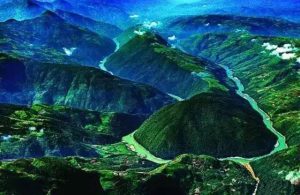
The natural landscape comprises three great rivers of East Asia, namely, the Jinsha River (the upper reaches of the Yangtze River), the Lancang River (the upper reaches of the Mekong River), and the Nujiang River (the upper reaches of the Salween River). Originating in the Tanggula Mountain on the Qinghai-Tibet Plateau, the three rivers flow parallel along the Hengduan Mountains for several hundred kilometers.
The Mekong runs through a gorge 310 km long. It crosses both Cambodia and Vietnam, and is the source of much of the food supply in both countries. The Yangtze River is China’s largest riverand the world’s 6th biggest. It stretches from here through Chongqing and Wuhan and ends at Shanghai. The Salween is important for the livelihood of the ethnic people in Burma and Thailand. The river valley in Burma is known for its beauty, and it flows to the Indian Ocean.
Geologic Origin of Three Parallel Rivers
The Three Parallel Rivers of Yunnan Protected Areas is representative of landscapes demonstrating the Earth’s evolution over major geological time periods and bio-evolution at important phases. In ancient times, as a result of the collision between India Plate and Eurasian Plate, the Qinghai-Tibet Plateau was ballooned up, creating the parallel mountains and rivers within a length of 150 kilometers, including the Dulong River, Gaoligong Mountain, Nu River, Lancang River, Yunling Mountain and Jinsha River in this area. Therefore the natural sceneries here are quite unique not only in China, but also in the world.
Features of Three Parallel Rivers Natural Reserve
The natural scenery of Three Parallel Rivers is located at the deep narrow valleys in the mountainous areas of the southern part of Qinghai-Tibet Plateau, in southwest China’s Yunnan Province. On this piece of land, there are high mountains, deep valleys, snow-capped peaks, large glaciers, lakes with potable water, wild forest, marshy grassland, rare animals and precious plants.
The height of snow-covered mountains in this area varies from 2,000 meters to 6,000 meters, and there are over 100 snow-covered mountains higher than 5, 000 meters, with Meili Snow Mountain as the top one. The deep gorges of Nu River Gorge(eg. Oriental Grand Gorge), Lancang River Gorges and Jinsha River Gorges(eg. Tiger Leaping Gorge) are particularly famous. There are 20% Higher Plants and over 25% more animals in this area including Yunnan golden monkeys, antelopes, snow leopards, Bengalese tigers and black necked cranes.

Its demographic make-up also is highly interesting as it contains many of the twenty-five minorities found in Yunnan province including the Derung, the smallest of all of China’s minority groups. Some of the other minorities found in this region are the Tibetan people, the Nu people, Lisu, Bai, Pumi and Naxi. Many of these minorities still use traditional costumes as their normal daily attire.
How to Get to Three Parallel Rivers Natural Reserve
To Lijiang City:
Lijiang is easily reachable since becoming a popular tour destination at the end of the 1990s. Tourists can take flight, train or coach getting there. More info please refer to Lijiang Transportation.
To Diqing Prefecture:
With a small regional airport, Shangri-La mainly relies on its roads as the main means of transportation. Tourists can take the flight or coach getting there. More info please refer to Diqing Transportation.
To Nujiang Prefecture:
Tourists need to get to Liuku in Nujiang Lisu Autonomous Prefecture first, and then take the local bus to Fugong, Gongshan and Bingzhongluo Village. This itinerary gives visitors a chance to explore the Nu River Gorge. More info please refer to Nujiang Transportation.
Main Attractions
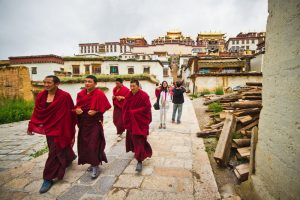
Shangri-La
Shangri-La is depicted as “Eden in dream” by British novelist James Hilton’s Lost Horizon in the 1939, a famous area with numerous natural landscapes and unique Tibetan customs. The main attractions in Shangrila include Songzanlin Lamasery, Pudacuo National Park, Meli Snow Mountain, Baishuitai, Tiger Leaping Gorge, etc.
Lijiang City
Lijiang, a popular destination in Yunnan, is considered as a fairyland blessed with fresh air, clear streams, breathtaking snow mountains and an undisturbed landscape inhabited by a friendly group of people. The main attractions include Lijiang Old Town, Jade Dragon Snow Mountain, Tiger Leaping Gorge, Lashi Lake, Lugu Lake, etc.
Nujiang Area
There are much to see or to do in Nujiang. Minorities in Nujiang is the most diverse in China and the population of minorities is the largest. The main attractions include Nujiang Grand Canyon, Bingzhongluo scenic Area, Gaoligongshan Mountain, Dulongjiang valley, etc.
Tours including Three Parallel Rivers Natural Reserve
10 Days Three Parallel Rivers Circle Tour with Nanjiluo and Biluo Snow Mountain Hiking
12 Days Yunnan Three Parallel Rivers Overland Tour with Biluo and Meili Snow Mountains
13 Days Three Parallel Rivers Circle Adventure with Tiger Leaping Gorge and Yubeng Village Hiking Tour
15 Days Three Parallel Rivers Overland Adventure with Dulongjiang River Valley and Tiger Leaping Gorge Hiking
20 Days Yunnan Three Parallel Rivers Adventure Trekking Tour
46 Days Yunnan Panorama Photography Tour with 25 Ethnic Minorities Discovery and Three Parallel Rivers Hiking Adventure
Why is Luchong Scenic Area So Special?
Luchong Scenic Area禄充景区 is located at the west bank of Fuxian Lake. There are beautiful Fuxian Lake, Bijia hill, Yusun hill玉笋山 and ancient banyan trees in the scenic area. It is a perfect scenic spot for leisure vacation. Fuxian Lake is one of the cores in Luchong Scenic Area, there are various outdoor activities along the Fuxian Lake. Rowing boat in Fuxian Lake, accompanied by blue sky and green water, is very comfortable. Bijia Mountain笔架山 is a good viewing point. Climbing up to Bijia Mountain and overlooking the whole Fuxian Lake, the scenery is unique. It is also one of the photography lovers’ favorite shooting spots.

Luchong Scenic Spot is the most beautiful scenic spots on the west bank of Fuxian lake, 19 kilometers away from Chengjiang county. Important attractions of Luchong scenic spot include Jianshan mountain尖山, Qilin mountain麒麟山, Wenchang palace文昌宫, Grand Buddha temple大佛寺, Laoyu village老渔村, Dadong Cave大洞, golden beach, Bosiwan波息湾, Biyan park笔砚公园 and Bijia hill笔架山. With the completed tourist facilities and colorful entertainment projects of the scenic area, Luchong Scenic Area is an ideal place for sightseeing and leisure.
Features of Luchong Scenic Area
The most eye-catching view of Luchong is the dense banyan trees along the lake. The youngest banyan trees among them are about seventy or eighty years old, and the majority of banyan trees are “centenarians” which have flourishing branches. At the foot of the Bijia Hill笔架山, there are two trees sharing one same root. You even can not tell they’re one tree or two trees, therefore local people call them “Albizzia tree合欢树”.
The scenic area provides the scenery of the scenic Fuxian Lake, Bijia Hill, Yusun Hill, ancient banyan trees and revolving water wheels, of all the scenery make up a picturesque painting.
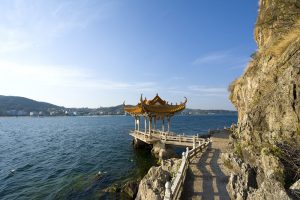
There is a Luchong big hole禄充大洞 in the south of Luchong village禄充村, which is rich in underground springs. The water temperature maintains around 24 ℃, flowing into Fuxian Lake constantly. In the summer and autumn, spinning the water wheels to catch Kanglang fish here has been a great wonder.
Nearby Attractions
1. Hu Pan Sheng Shui湖畔圣水
Located in the northeastern side of Fuxian lake, Hu Pan Sheng Shui is 11 kilometers from Chengjiang county. A comprehensive international leisure resort integrates hotel rooms, special catering, Spa, leisure entertainment and wetland park. The scenic area consists of Fuxian lake Yuechun resort Hotel and Yueliang bay ecological wetland park.
2. Cherry Blossom Valley樱花谷
3. Mingxing Scenic Spot明星景区
Mingxing scenic spot includes Mingxing fish cave明星鱼洞 and Biyun mountain碧云山 two major scenic spots. Mingxing fish cave is located on the west bank of Fuxian lake, about 1 km from Mingxing village, Jiangchuan district, Yuxi city.
4. Gushan Mountain Scenic Spot孤山景区
Gushan scenic spot is the earliest scenic spot developed by Fuxian lake and the first provincial scenic spot in Yunnan province. A number of high-end hotels, including Sunshine Coast, Ruiwen Hotel and Yuboyuan Hotel, as well as rural featured farmhouses, ruby beach and Qinjiawan beach, all of these constitute a tourism service system integrating food, accommodation, travel, shopping and entertainment.
Best Time to Visit
Enjoying a subtropical monsoon climate, tour is possible all the year round. With warmest sun, softest beach and clearest water, Luchong Scenic Area, the most beautiful scenic spot in the west bank of Fuxian Lake, is a excellent place to escape the heat in summer.
How to Get there
Luchong Scenic Area禄充景区 is located in the west shore of Fuxian Lake, 19 km away from Chengjiang County. Bus is the main means of transportation to Luchong Scenic Area in Fuxian Lake. Surely, you can also drive.
Kunming-Chengjiang County
There are midibuses from Kunming South Bus Station to Chengjiang County. It takes about 1 hour and a half to Chengjiang Bus Terminal. Ticket price is about 20 yuan each person. The phone number of Kunming South Bus Station is 0871-67361722.
Chengjiang County Bus Terminal-Luchong Scenic Area
In Chengjiang county, you can take No.2 bus and No.8 bus to reach the scenic spots along Fuxian lake respectively. There are buses in Chengjiang bus terminal, you can see them when you get off the midibus. You can ask the driver, from which you can get the detail information. Taking the No. 8 bus can reach directly to Luchong Scenic Area. It takes about an hour from Chengjiang bus terminal to Luchong Scenic Area.
Accommodation Around Luchong Scenic Area
There are many hotels around Luchong Scenic Area. You can stay around the scenic area for overnight when you are traveling.
1. Lanhai Holiday Hotel澄江蓝海假日酒店
Address: No.3, Rong Shu Wan, Luchong Village, Longjie Town, Chengjiang County, Yuxi 玉溪市澄江县龙街镇禄充村榕树湾3号
Tel: 0877-6610215
Starting Price: 173 CNY
2. Luomi West Bank Resort Hotel抚仙湖罗蜜西岸度假酒店
Address: Qilin Road, Luchong Scenic Area, Chengjiang County, Yuxi玉溪市澄江县禄充风景区麒麟路
Tel: 0877-6762188
Starting Price: 172 CNY
3. Luchong Shui Bian Xiao Zhu澄江禄充水边小筑
Address: Yangjiaxiang Lakeside, Luchong Scenic Area, Chengjiang County, Yuxi玉溪市澄江县禄充风景区杨家巷湖畔
Tel: 15198877695
Starting Price: 145 CNY
Useful Travel Tips
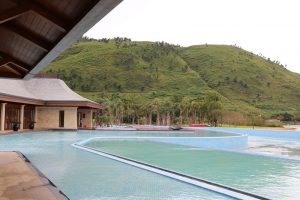
1. Fuxian Lake is a plateau lake, and Luchong Scenic Area is popular in summer. Ultraviolet ray is strong in summer, when you travel Luchong Scenic Area in Fuxian Lake in summer, remember to bring sunglasses, sun cream, sunhat or other sunscreen products.
2. The water in Fuxian Lake is deep, with 155 meters of its greatest depth. Therefore, if you are not good at swimming, please wear the life vest when you are doing some water sports.
Fuxian Lake Overview
Located in Chengjiang county, which is 52 kilometers away from Kunming, Fuxian lake is 5 kilometers away from the county seat of Chengjiang county. It is the deepest plateau fresh water lake in China, with an area of about 212 square kilometers and a maximum depth of 155 meters, with an average depth of 95 meters and a maximum transparency of 8 meters. The lake is 1722.5 meters above the sea level. The water quality is national class water, the net purity of the lake is more than 99%, and the water storage is extremely large.
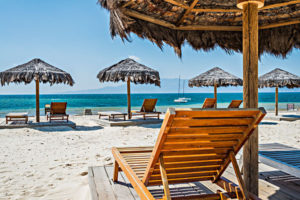
The beauty of Fuxian lake cannot be separated from the limpid water of Fuxian lake. As early as the late Ming dynasty, traveler Xu Xiake in his Travels of Xu Xiake noted that “the mountains of Yunnan are rich in soil, therefore, obstructing the flow into the sea, and the flow is turbid, but Fuxian lake is the clearest”.
Features of Fuxian Lake
Fuxian lake is a holiday paradise! Authority personage evaluated Fuxian lake like this, she is big outdoor bathing place, a big oxygen bar! There are 42 tourism enterprises with a set of tourism, scientific research, entertainment, meeting and holiday reception. Part of the lakeside resort tourism facilities set hotels, beaches, entertainment, such as Xiangshan Hotel象山宾馆, transport training center, Yurong resort玉融度假区, Bijia mountain笔架山, Boxiwan resort波息湾度假区 and so on. Fuxian Lake is the first choice for vacation leisure and conference.
The water temperature of Fuxian lake changes little in summer and winter, and with good water quality, it is an excellent place to swim. It attracts thousands of people to play here every year. Warmest sun, softest beach and clerest water make Fuxian Lake’s summer become people’s favorite. More than 100 kilometers of road around the lake has been repaired, which is the best place to start walking, cycling and driving around the lake. There are various water sports in Fuxian Lake, such as diving, water cycling, kayaking, sailing, single boat.
How to Get There
Bus is the main means of transportation to Fuxian Lake. Surely, you can also drive.
Kunming-Chengjiang County
There are midibuses from Kunming South Bus Station to Chengjiang County. It takes about 1 hour and a half to Chengjiang Bus Terminal. Ticket price is about 20 yuan each person. The phone number of Kunming South Bus Station is 0871-67361722.
Chengjiang-Fuxian Lake
In Chengjiang county, you can take No.2 bus and No.8 bus to reach the scenic spots along Fuxian lake respectively. Or there are buses in Chengjiang bus terminal, you can see them when you get off the midibus. You can ask the driver who can tell you the detail information.
Main Attractions in Fuxian Lake
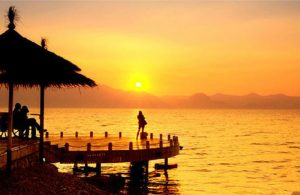
1. Hu Pan Sheng Shui湖畔圣水
Located in the northeastern side of Fuxian lake, Hu Pan Sheng Shui is 11 kilometers from Chengjiang county. A comprehensive international leisure resort integrates hotel rooms, special catering, Spa, leisure entertainment and wetland park. The scenic area consists of Fuxian lake Yuechun resort Hotel and Yueliang bay ecological wetland park.
2. Cherry Blossom Valley樱花谷
3. Luchong National AAAA Scenic Spot禄充国家AAAA级景区
Luchong Scenic Spot is the most beautiful scenic spots on the west bank of Fuxian lake, 19 kilometers away from Chengjiang county. Important attractions of Luchong scenic spot include Jianshan mountain尖山, Qilin mountain麒麟山, Wenchang palace文昌宫, Grand Buddha temple大佛寺, Laoyu village老渔村, Dadong Cave大洞, golden beach, Bosiwan波息湾, Biyan park笔砚公园 and Bijia mountain笔架山.
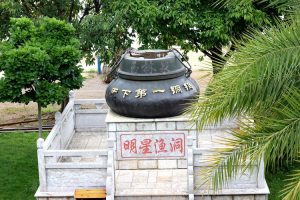
4. Mingxing Scenic Spot明星景区
Mingxing scenic spot includes Mingxing fish cave明星鱼洞 and Biyun mountain碧云山 two major scenic spots. Mingxing fish cave is located on the west bank of Fuxian lake, about 1 km from Mingxing village, Jiangchuan district, Yuxi city.
5. Gushan Mountain Scenic Spot孤山景区
Gushan scenic spot is the earliest scenic spot developed by Fuxian lake and the first provincial scenic spot in Yunnan province. A number of high-end hotels, including Sunshine Coast, Ruiwen Hotel and Yuboyuan Hotel, as well as rural featured farmhouses, ruby beach and Qinjiawan beach, all of these constitute a tourism service system integrating food, accommodation, travel, shopping and entertainment.
More scenic spots include Taiyang mountain international landscape resort太阳山国际山水度假地, North Fuxian Lake Ecological Wetland and Haimen Gehe Scenic Spot海门隔河景区.
Recommended Hotels in Fuxian Lake
Here below are some hotels you can choose when you are traveling in Fuxian Lake.
1. Fuxian Lake Taiyangshan Resort Hotel抚仙湖太阳山度假酒店
Address: No.10, Huanhu East Road, Chengjiang County, Yuxi玉溪市澄江县环湖东路10号
Tel: 0877-6688706
Starting Price: 410 CNY
2. Fuxian Lake Guanlan Resort Hotel抚仙湖观澜度假酒店
Address: No.8, Huanhu North Road, Chengjiang County, Yuxi玉溪市澄江县环湖北路8号
Tel: 18108879725
Starting Price: 129 CNY
3. Fuxian Lake Junlin Holiday Hotel抚仙湖君临假日酒店
Address: No.8, Huanhu North Road, Chengjiang County, Yuxi玉溪市澄江县环湖北路8号
Tel: 0877-6222077
Starting Price: 128 CNY
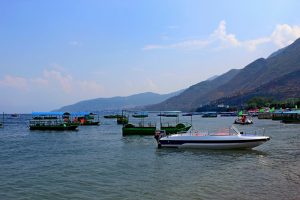
Best Time to Visit
Enjoying a subtropical monsoon climate, tour is possible all the year round. With warmest sun, softest beach and clearest water, Fuxian Lake is a excellent place to escape the heat in summer.
Recommended Tour
When you traveling Yuxi, Fuxian Lake is the best choice to enjoy yourself. Tours in Fuxain Lake are always related to the hot destinations in Yunnan, like Kunming, Jianshui, Yuanyang and so on.
Useful Travel Tips
1. Sunscreen
Fuxian Lake is a plateau lake, and it is popular in summer. Ultraviolet ray is strong in summer, when you travel Fuxian Lake in summer, remember to bring sunglasses, sun cream, sunhat or other sunscreen products.
2. Safety
The water in Fuxian Lake is deep, with 155 meters of its greatest depth. Therefore, if you are not good at swimming, please wear the life vest when you are doing some water sports.
3. Tickets
For admission fee, some scenic spots are free of charge, while some are charged.
Luchong Scenic Spot: 15 Yuan each person
Gushan Scenic Spot: 15 Yuan each person
Yueliangwan Wetland Park: 30 Yuan each person
Maotianshan Geopark: 20 Yuan each person
Xinhekou Lakeside Park: Free
Cherry Blossom Scenic Spot: Free
Fuxian Lake Rare Stone Museum: Free
Why is Dashanbao Black-necked Crane Nature Reserve So Special?
Dashanbao is one of the most popular destination for Yunnan Birding Tours. Covering a total area of 19,200 hectares, the Reserve is a plateau marshland. There are more than 1,300 black-necked cranes wintering in Dashanbao Reserve which has become the largest winter habitat of black-necked cranes and is regarded as one of the “Hometowns of Black-necked Cranes in China”. The reserve has been designated as a Ramsar site since 2004.
Where is Dashanbao Black-necked Crane Nature Reserve – Location
Dashanbao Black-necked Crane Nature Reserve is situated in Dashanbao Township in Zhaoyang District of Zhaotong Municipality, geographical east longitude 103 ° 14 ’55” ~ 103 ° 23′ 49″, north latitude 27 ° 18 ’38” ~ 27 ° 29 ’15”.
History and Culture
A “first class protected species,” black-necked cranes winter in the Wulianfeng Mountain area of Zhaotong Prefecture from early November to early April, residing in high elevation wetlands, including swamps, marshy pastures, reservoirs and pools, at altitudes ranging from 2,200 to 3,300 meters. A synchronized headcount at several localities in January 1998 found 1,332 birds. But a repeat count two years later tallied only 808 birds.
In order to try to help protect this endangered species, Zhaotong Prefecture established the Dashanbao Black-Necked Crane Nature Reserve in 1990, covering all 192 square kilometers of Dashanbao Township.
In 1990, Dashanbao Black-necked Crane Nature Reserve was approved by the people’s government of Zhaotong city.
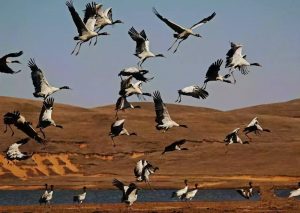
In 1994, it was approved by the people’s government of Yunnan province to be upgraded to a provincial nature reserve.
In 2003, it was approved to be a national nature reserve by the state council .
In 2005, Dabanbao wetland in Yunnan was listed as an international important wetland.
Natural Resources
Animals: The most valuable protected animal in Dashanbao Nature Reserve is black-necked crane. According to official statistics, its number has increased to approximately 1130 from 300 in 1990; other birds include: erne, gray crane, goshawk, glede, sparrow-hawk, common buzzard, white-tailed willet and Asian barred owlet etc. There are 68 species of animals, among which there are 10 species of mammals, 52 species of birds, 5 species of fish; 3 species of reptile; 3 species of amphibia. The black-necked crane is the main protected object.
Plants: There are 56 families of vascular plants, falling into 131 genera and 181 species, including ferns of 9 families, 10 genera, and 11 species; spermatophyte of 47 families, 121 genera and 170 species. Simultaneously animals protected inside include 10 orders, 28 families and 68 species.
Values of Dashanbao Black-necked Crane Nature Reserve
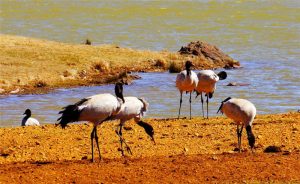
The black-necked crane is a first-level protected animal in China. It mainly breeds on the Qinghai-Tibet plateau and overwinters on the Yunnan-Guizhou plateau. It is the only crane among the world’s 15 species of cranes that breeds and overwinters on the plateau. According to the simultaneous survey of black-necked cranes conducted by the forestry department of Yunnan province and the international crane foundation (ICF) in 2002, 930 black-necked cranes stayed over winter in the protection area of Dashanbao in 2002, and the survey data of the same survey time in 2003 was 1,043. Dashanbao has become the protection area with the largest distribution of black-necked cranes per unit area in China.Due to its fixed migration route every year, Dashanbao is also responsible for protecting the specific environment to the survival of the black-necked crane of subalpine meadow and marsh meadow.
Current Situation
Since the time when Dashanbao Nature Reserve was established, sub-alpine wetland and wet grassland, which are the major habitat of the black-cranes to spend winter in Yunnan, have been conserved effectively. It is of great significance for conservation of the bio-diversity. Now, Dashanbao has been listed in international important wet lands and China’s national-level natural reserves.
Today there are more than 1,300 black-necked cranes wintering in Dashanbao Reserve which has become the largest winter habitat of black-necked cranes and is regarded as one of the “Hometowns of Black-necked Cranes in China”. The birds have gradually attracted researchers, photographers and tourists. To avoid disturbance, a tunnel was built in the Reserve. It is covered by grass and there is a row of window on the upper part of tunnel. Anyone who wants to watch and take photos of black-necked cranes shall stay in the tunnel.
How to Get there
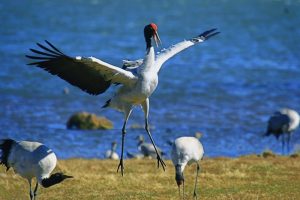
Trains, buses and planes are optional ways from Kunming to Zhaotong. There are several trains from Kunming to Zhaotong. At least, the train journey is about 9 hours. Via expressway, Zhaotong City is about 350 km away from Kunming. The flight time is about 1 hour. Dashanbao is about 80 km away from the seat of Zhaotong. There are regular buses. Howerver, self-driving is more convenient.
The best way for tourists to get to Dashanbao is car-rental. Many of the attractions in the scenic spot are 2- 5 kilometers away from where you are staying.
Best Time to Go
The best traveling time is autumn and winter. From the beginning of August to the beginning of October, the flowers, oat and grass on the mountain are all in pieces, stacked on top of each other, with various colors. In the winter, large numbers of black-necked cranes migrate to Dahaizi Wetland from Tibet Plateau in the end of October, and leave in April the next year when the black-necked cranes “dance” on the wetland, leaving deep impressions on tourists’ minds.
Accommodate at Dashanbao Black-necked Crane Nature Reserve
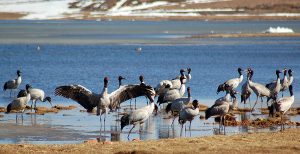
If you want to see the sea of clouds and sunrise, it is recommended to stay at Dashanbao Town while if you just want to watch the sunset, stay at the Zhaotong city where the accommodation condition is better.
Attractions Nearby
Huanglianhe Scenic Area:
Located in Daguan County, it has a grand waterfall group hidden in the depths of the mountain valleys. Water curtains, caves and many other spectacles make this scenic area an attractive spot in Zhaotong.
Islamic Style Park:
It is only 5 kilometers away from Ludian county seat. It is a national tourist attraction integrating the ethnic culture, wedding culture, food culture, clothing culture of Hui ethnic people and the most distinctive ethnic tourism in southwest China.
Wanghailou Tower:
Wanghai Tower is located in the southern suburbs of Zhaotong city at the foot of Fenghuangshan mountain, built in the Qing dynasty(Qianlong 25 years). It was designated as a city-level cultural relic protection unit in 1983.
Useful Travel Tips
► If you want to see the black-necked crane, it is better to come from the end of September to the end of January.
► There are strong ultraviolet rays at Alpine meadow, so protect yourself from the sun.
Tours including Dashanbao Black-necked Crane Nature Reserve
6 Days Northeast Yunnan Winter Birding Tour to Dianchi Lake, Nianhu Lake and Dashanbao
8 Days Yunnan Winter Birding Tour to Dongchuan Red Land, Nianhu Lake and Dashanbao Nature Reserve
Chinese Name:大理崇圣寺三塔
English Name: Three Pagodas and Chongsheng Monastery, Dali
An overview of The three pagodas
The magnificent Chongsheng Temple and the well-known Three Pagodas are the symbol of Dali. Originally, the Chongsheng Temple was built in the time of Kingdom of Nanzhao in 10th century to be near the Dali Three Pagodas, so people call them “Chongsheng Temple and Three Pagodas”. If you look at it from a distance, the pagodas are like three giant ballpoint pens breaking up the landscape of the never-ending mountains and emerald rice fields of Yunnan.
Where is it located?
Three Pagoda of Chongsheng Temple is located 1.5 kilometers northwest of Dali Old Town. It is situated at the east foot of Yingle Peak of the massive Cangshan Mountain and faced the west shore of Erhai Lake of ancient Dali. There are two rivers flowing through, one is Tao Stream in the east and Mei Stream in the north.
Distance from other Famous Attractions in Dali
- About 2.6 kilometers from Cangshan Mountain
- About 1.5 kilometers from Dali Old Town
- About 6.6 kilometers from Erhai Lake
- About 23.1 kilometers from Shuanglang
Highlights
Three Pagodas (三塔)
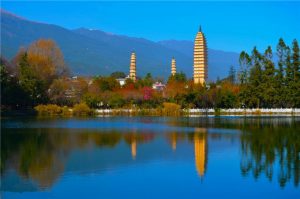
The Three Pagodas are made of one big pagoda and two small pagodas, forming a symmetric triangle. The Three Pagodas are made of brick and covered with white mud. The purpose of Three Pagodas, as so often in China, is to magically guard against natural disasters, particularly earthquakes and floods, as per the four-character inscription on the tall pagoda: “Forever Control Mountains and Rivers.”
The main pagoda is known as Qianxun Pagoda which was first built during 823-840 AD by King Quan Fengyou of Nanzhao Kingdom. Qianxun Pagoda is square shaped and stands 69.4 meters high. The appearance of Qianxun Pagoda is much similar with the Small Wild Goose Pagoda in Xian, Songyue Temple Pagoda is Dengfeng and While Horse Temple Pagoda in Luoyang. Qianxun Pagoda has sixteen stories and each story has multiple tiers of upturned eaves and a carved shrine containing a while marble sitting Buhhda statue.
The other two sibling pagodas, at 42.19 meters high, stand to the northwest and southwest of Qianxun Pagoda and they are octagonal with ten multi-eave pent roofs. From their structure and shape, the two small pagodas should be built in the Dali Kingdom of the Song Dynasty style.
Chongsheng Temple (崇圣寺)
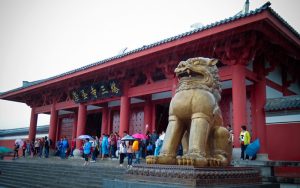
Chongsheng Temple complex is located behind the Three Pagodas which was the royal temple of Dali and one of t6he largest Buddhist centers in Southeast Asia. There are many sites to explore in front of Chongsheng Monastery and in the monastery.Walk behind Three Pagodas you’ll reach Dapeng Golden Wing Bird Square and see the Golden Wing Bird and explore the biggest bell in Yunnan – Nanzhao Jianji Bell which was built in 871 AD. Entering into the temple, you’ll pass many Buddhist prayer halls, like Daxiongbao Hall, Medicine Hall, Caishen Hall, Maitreya Hall, Arhat Hall, Prayer Wheel, Thousan Buddha Hall, the Hall of Patriarch and finally reach Wanghai Tower where all the temple complex, the Three Pagodas, Cangshan Mountain and Erhai Lake can be seen.
Tours including Three pagodas
Admission Fee:¥121
Opening Hours: 8:00-19:00
Attraction Transportation:
Travelers can feel free to use our private car taking to Three Pagodas in Dali. If you are independent travelers, you can take bus or go by walking.
- Dali Old Town – Three Pagodas Sightseeing Tourist Bus: The direct sightseeing buses between Dali Old Town Tourist Center and Chongsheng Three Pagodas are available during 08:30~17:30. It only needs 10 minutes for the drive.
- Daili Old Town North Gate – Three Pagodas: Travelers can take 20~30 minutes’ walk from the North Gate of Dali Old Town to Three Pagodas. Buses also available and you can take No.19 bus from the North Gate to Three Pagoda Park.
Attraction Travel Tips:

- Battery cars in the tourist area are available in several spots – Entrance Gate, Reflection Pond, Daxiongbao Hall, Wanghai Tower. It takes 25 Yuan for battery cars.
- Photographers should catch the best scenery of Three Pagodas and Chongsheng Temple in two famous spots – the Reflection Pond and Wanghai Tower. The Reflection Pond is a good site to capture full-face photo, pagoda, blue sky and white cloud reflection in the water, in this way, “the six pagodas” would get into your pictures. Standing on the top of Wanghai Tower, travelers can capture full view of Three Pagodas and Chongsheng Temple in a line and Erhai Lake from afar.
Why is Songzanlin Monastery So Special?
Built in 1679, the monastery is the largest Tibetan Buddhist temple complex in Yunnan province and one of the famous monasteries in the Kang region, which belongs to the Yellow Hat sect of Tibetan Buddhism of the Gelukpa order of the Dalai Lama. It is reputed as the Little Potala Palace due to its complex of Potala Palace in Lhasa, Tibet. Located in the capital of Diqing Tibetan Autonomous Prefecture, it is also the most important monastery in southwest China.
Where is Songzanlin Monastery – Location
The Ganden Sumtsenling Monastery, also known as Sungtseling and Guihuasi, is situated 5 kilometres from the city of Shangrila at elevation 3,380 metres (11,090 ft) in Yunnan province, China. The specific location is at the foot of Fopingshan Mountain (佛屏山), Shangrila City.
Distance from other attractions in Shangri-La
About 5.6 km from Duzekong Old Town and Guishan Hill
About 26.2 km from Pudacuo National Park
About 85.6 km from Tiger Leaping Gorge
History and Culture
Construction of the monastery began in 1679 and was completed in 1681. The Fifth Dalai Lama decided the location though divination and gave the name—Gedansongzanlin (噶丹松赞林). “Ganden” has relationship with Ganden Monastery in Tibet which was built by Tsongkhapa of Gelug Sect. It was built during the rule of the Qing dynasty Kangxi Emperor. He fully patronized the development of this monastery. It is also said that the emperor was associated in the reincarnation search for the Seventh Dalai Lama.
In the 1930s, the monastery had provided full support to the Communist general He Long who passed through this area during his campaign. It was extensively damaged in the Cultural Revolution and subsequently rebuilt in 1983; at its peak, the monastery contained accommodation for 2,000 monks; it currently accommodates in its rebuilt structures 700 monks in 200 associated houses.
The monastery is full of treasures. There are a lot of golden figures of Buddha josses, golden lamps, Tibetan lections, silver censers and so on. All of these are wonderful collections accumulated from each dynasty.
Architecture
The architecture of Songzanlin Monastery is a fusion of the Tibetan and Han Chinese. The monastery has two major lamasery buildings – Zhacang and Jikang – apart from several smaller lamaseries. The main monastery structure built in Tibetan style has a gilded copper roof similar to the one at the Potala Monastery in Lhasa. The other buildings in the complex are built in Han Chinese style.
It has six main structures including eight colleges. The entrance gate is at the foot of the hill and provides access to the main hall of the monastery through 146 steps. In the main hall of the monastery, more than 1500 monks congregate to recite the Buddhist scriptures. This hall houses a plethora of scriptures written on palm leaves, a gilded statue of Shakyamuni Buddha which is 8 metres (26 ft) tall at the main altar along with paintings depicting the life of Buddha. The altar has permanent decorated by yak butter lamps.
How to Get to Songzanlin Monastery?
Getting to Songzanlin Monastery is relatively straightforward, as it is located just 5 kilometers (3 miles) north of Shangri-La’s city center at the foot of Foping Mountain. Here’s how you can reach the monastery:
Transportation Options:
- Taxi or Public Bus:
- From Dekezong Ancient Town: You can take a taxi or a public bus from Dekezong Ancient Town, which is just south of Shangri-La’s city center. The journey is short, and taxis are generally affordable, making it a convenient option.
- Bus: Local buses also run to the monastery, but they may not be as frequent or comfortable as a taxi.
- Private Transfer (Highly Recommended):
- Convenience: A private transfer offers more flexibility and comfort, especially if you’re planning to visit multiple attractions on the same day.
- Local Guide Service: By opting for a private transfer, you can also benefit from an English-speaking guide. A local guide can provide deeper insights into the history, culture, and daily life of the lamas at Songzanlin Monastery, enhancing your visit.
- Customized Itinerary: With a private driver, you can easily combine your visit to the monastery with other nearby attractions, such as Pudacuo National Park, making your day trip more efficient and enjoyable.
Day Trip Considerations:
- Combined Visits: Many visitors choose to visit Songzanlin Monastery along with Pudacuo National Park, which is only a 40-minute drive away. A private guide and driver service can help you maximize your time and ensure a hassle-free experience, allowing you to focus on enjoying the sights.
Whether you choose a taxi, public bus, or a private transfer, getting to Songzanlin Monastery is easy, and the journey itself offers scenic views of the surrounding Shangri-La area.
Main Attractions
►Main Scripture Hall
In the main hall of the monastery, more than 1500 monks congregate to recite the Buddhist scriptures. This hall houses a plethora of scriptures written on palm leaves, a gilded statue of Shakyamuni Buddha which is 8 metres (26 ft) tall at the main altar along with paintings depicting the life of Buddha. The altar has permanent decorated by yak butter lamps.
►Dratsang Basilica
Covering an area of 1500 square meters and 39.6 meters tall, it is one of the earliest constructions in Songzanlin Monastery built in 1697 A.D, 18th year in Emperor Kangxi period in Qing dynasty, the period when the 5th genealogy of Dalai was reigned. Dratsang Basilica is the place for monks chanting together in Songzanlin Monastery. And inside the Dratsang Basilica, there are enshrined the 5th genealogy of Dalai Lama Jwasang, Zongkeba Buddha, Jamba Buddha, Sakyamuni Buddha, the 3rd genealogy of Dalai, the 7th genealogy of Dalai, the 10th genealogy of Panchen Jwasang.
►Sakyamuni Basilica
Built in 1697 A.D, 18th year in Emperor Kangxi period in Qing dynasty and covering an area of 556 square meters, it is also known as Wenshu Buddha Basilica. Inside there are enshrined Wenshu Buddha with the height of 13.58 m, and Sakyamuni Buddha with pictures described his life around him.
►Zha Laju Religious Rituals Magic Basilica
Being one of the earliest constructions in Songzanlin Monastery and covering an area 159 square meters, it was also built in 18th year in Emperor Kangxi period in Qing dynasty. Inside, it enshrined custodian of immortals.
►Zong Keba Basilica
Built in 1697A.D and covering an area of 789 square meters, it is 36 m high with 4 exceedingly high posts known as Gold Tile Temple for the flammule-flashing gold tile which could be seen a few miles away. Inside, there is enshrined The First Buddha in Tibetan Areas ZongKeBa master Jwasang with the height of 18 m.
►Lamuyangcuo Lake
Located in front of the Songzanlin Monastery, it is a holy lake dwelled by the soul of Goddess Bandanlamu, a guardian goddess of universe. Lamuyangcuo, means the Soul of Heaven Fairy Lake. The celestial burial platform is standing in its south. In every important Buddhist ritual or the occasion of making major decisions, the monks and believers led by the Rinpoche chant sutras and pray around the lake.
How to Travel Around Songzanlin Monastery
- Sightseeing Bus Service: The entrance ticket to Songzanlin Monastery includes a sightseeing bus service. This bus will take you from the tourist center to the monastery, which is about 3 kilometers away. This service is convenient and helps visitors avoid the steep walk up to the monastery.
- Walking Inside the Scenic Area: Once you arrive at the monastery, walking is the best way to explore. The monastery complex is large and includes various halls, temples, and living quarters for the monks. You can stroll through the prayer halls, circumambulate the main temple, and take in the views of the surrounding landscape.
- Exploration Tips:
- Wear Comfortable Shoes: The paths around the monastery can be steep and uneven, so comfortable walking shoes are recommended.
- Altitude Awareness: The monastery is located at an altitude of about 3,300 meters, so take your time walking around to avoid altitude sickness.
- Photography: While photography is allowed in most outdoor areas, be mindful of restrictions inside certain temples and prayer halls.
- Respectful Behavior: As an active place of worship, it’s important to be respectful, maintain silence in prayer areas, and follow any posted guidelines.
- Additional Activities: If time allows, consider exploring the surrounding area, including the nearby Lamuyangcuo Lake, which is known for its scenic beauty and reflection of the monastery.
Best Time to Visit Songzanlin Monastery (Ganden Sumtseling Monastery)
From March to May and September to November is the best time to visit Songzanlin Monastery when the scenery of Shangri-la is beautiful. From June to September is the rainy season of Shangrila and winter is very cold with snow. So take enough clothes to keep warm if you visit it in the winter times. During every Dec.26 to Dec.29 by Tibetan calendar, the grand Gedong Festival is held to worship and also to witness the religious mask dances – the Cham dance, which is a rare chance in Shangrila to experience the Tibetan Buddhism culture and religion.
- Year-Round Photography: The monastery is picturesque throughout the year, offering excellent opportunities for photography.
- Gedong Festival: A grand religious festival called the Gedong Festival takes place annually from December 26th to 29th (Tibetan calendar). During this festival, you’ll witness a unique cultural experience with masked dances, yak butter oil lamps, and devout pilgrims, providing a rare insight into Tibetan Buddhism.
- Weather Considerations: The climate in Shangri-La can vary significantly with the seasons, so it’s important to check the weather conditions before your visit.
Walking around Lamuyangcuo Lake
Walking around Lamuyangcuo Lake offers a serene and picturesque experience, complementing your visit to Songzanlin Monastery. Here’s what you can expect:
Exploring Lamuyangcuo Lake
- Scenic Beauty: Lamuyangcuo, meaning “Virgin Soul Lake,” is steeped in Tibetan mythology and is considered the “soul lake” of the goddess Badenglamu. The lake is a tranquil spot, surrounded by wildlife, including wild ducks, sparrows, white geese, and farm animals like cattle and sheep. The harmonious coexistence of these animals reflects the Buddhist philosophy of living in harmony with nature.
Walking Experience
- Boardwalk: A lakeside boardwalk allows you to take in the natural beauty of the area while viewing Songzanlin Monastery from different perspectives. The walk is peaceful, offering a meditative experience as you stroll by the water.
- Viewing Platforms:
- Center of the Lake: The first panoramic viewing platform is centrally located, providing a balanced view of the monastery against the lake.
- Conggulong Village: The second platform, near Conggulong Village, is known as the best viewpoint. From here, you can capture stunning photographs of the monastery with the lake in the foreground.
- Duration: It takes about 50 minutes to walk around the lake at a leisurely pace, allowing time to stop and enjoy the views.
Extended Exploration
- Dongqusheng Hill: If you’re up for more adventure, you can climb Dongqusheng Hill for a more distant and elevated view of the monastery. This vantage point offers a unique perspective, with the monastery framed by the surrounding landscape, making it an ideal spot for photography.
Walking around Lamuyangcuo Lake is a must-do activity that enhances your visit to Songzanlin Monastery, offering both natural beauty and cultural insights.

Admission Fee & Opening Hours
| Admission Fee | CNY 115 |
|---|---|
| Sightseeing Bus | CNY 20 |
| Opening Hours | 8:00 – 18:00 |
| Recommended Time for a Visit | 2-3hr |
Nearby Attractions
Pudacuo National Park in Shangri-la, Diqing
Being one of the most bio-diverse regions in China’s Yunnan Province, Pudacuo National Park is the first national park in Chinese mainland which was announced on June 25, 2007. With its crystal-clear lakes, undulating mountains and gurgling streams, Pudacuo National Park is definitely a wonderful natural wonderland. Among China’s 2,500 nature reserves, Pudacuo is the only one meets the standards for national parks established by The World Conservation Union. In addition to its rare vegetation and mammal species, the stunning natural beauty of landscape is unmissable for visitors as well.
As one of the largest and best-preserved Tibetan residence groups in China, the 1300-year-old Dukezong Ancient Town, situated at Shangri-la County, Deqing Tibetan Autonomous Prefecture, not only plays an important role in the Old Tea – Horse Road, but also serves as a corridor connecting Chinese and Tibetan language, people, religion and cultures. Until the fire disaster damaged the most of Tibetan dwellings in 2014, it still remains the traditional Tibetan architectural style.
Recommended Visiting Route
The whole time of visiting Songzanlin Monastery is about 2 hours. The entrance gate is at the foot of the hill and provides access to the main hall of the monastery through 146 steps. Tourists should pay attention to visit by clockwise. Besides, the Lamuyangcuo Lake is also a good spot to explore more Tibetan Buddhist culture which needs another 2 hours. Take it into consideration if you have enough time.
Useful Songzanlin Monastery Travel Tips
1. Manners & Taboos
- Dress Modestly: As a religious site, visitors should dress conservatively, covering shoulders and knees.
- Behavior: Maintain respectful behavior—talk quietly, avoid smoking, and follow a clockwise route when visiting temples.
- Photography Etiquette: Always ask for permission before photographing monks or pilgrims, and remember that photography is prohibited in the chapels.
2. Walking Tips
- Climbing the Stairs: To reach the main halls and temples, you’ll need to climb 146 steep stairs. Given the 3,300-meter altitude, it can be physically demanding, so pace yourself.
- Lamuyangcuo Lake Walk: The ring road around Lamuyangcuo Lake is 2,110 meters long, taking about 40 minutes to walk. It’s a scenic but energy-demanding walk.
3. Photography Tips
- Best Viewpoint: The CongGulong Village Viewing Deck offers the best panoramic views of the monastery. It’s located on the road to Lamuyangcuo Lake.
- Timing: Sunrise is around 07:00, and sunset is around 20:00. For the best sunset shots, arrive early and prepare to wait for the perfect moment.
- Inside the Monastery: Capture unique elements like Thangka paintings, palm-leaf scriptures, censers, and the light in the temples. Be mindful of capturing images of lamas and pilgrims respectfully.
How to Plan a Songzanlin Monastery (Ganden Sumtseling Monastery) Tour
When planning a tour that includes Songzanlin Monastery (Ganden Sumtseling Monastery), it’s essential to consider how much time you have and what other attractions you want to visit in the Shangri-La area. Here’s how you can organize your visit:
Exploring Songzanlin Monastery
- Duration: About half a day.
- Experience: Start your visit at the Songzanlin Monastery, exploring its rich Tibetan Buddhist culture, impressive architecture, and the surrounding scenic views. The monastery is the largest Tibetan Buddhist monastery in Yunnan, offering a deep dive into the region’s spiritual heritage.
Combine with Pudacuo National Park
- Location: About 40 minutes east of Songzanlin Monastery.
- Experience: Many visitors choose to visit Pudacuo National Park on the same day. This park is a natural haven, featuring beautiful lakes, lush meadows, and diverse wildlife, making it a perfect complement to the cultural experience at the monastery.
Extend Your Stay in Shangri-La
- Additional Attractions: For those with more time, consider exploring Dukezong Ancient Town, Tortoise Hill & Golden Prayer Wheel, and Xiagei Tibetan Culture Village. These sites provide a mix of history, culture, and stunning views.
- Meili Snow Mountain & Yubeng Village: If you’re interested in trekking and nature, you can extend your stay by 2-4 days to hike around Meili Snow Mountain and Yubeng Village, known for their breathtaking landscapes and spiritual significance.
Shangri-La and Beyond
- Shangri-La & Lijiang: Many visitors prefer to combine their Shangri-La trip with a visit to Lijiang, another popular destination in Yunnan. The two cities are connected by the stunning Tiger Leaping Gorge, making the journey between them an adventure in itself.
- Starting in Kunming: For a broader Yunnan experience, you can start your journey in Kunming, visiting the Stone Forest before heading to Shangri-La. This approach allows you to experience the diversity of Yunnan’s landscapes and cultures.
Extended Yunnan Tours
- Exploring More Destinations: If you want to see more of Yunnan, consider extending your tour to include Kunming, Dali, Lijiang, and even Yuanyang’s rice terraces or Xishuangbanna’s tropical landscapes. These extended tours can range from 6 to 15 days, depending on your interest and time.
By mixing cultural exploration with natural beauty, and possibly extending your journey to other parts of Yunnan, you can create a well-rounded and memorable travel experience.
Tours including Songzanlin Monastery and Explore Shangri La with Yaso Trip
7 Days Shangrila Students Education Course
8 Days Yunnan Classic Tour by High Speed Bullet Train
15 Days Yunnan-Tibet Mount Everest Tours from Kunming to Lhasa by Flight
Catholic Church of Dali Ancient Town
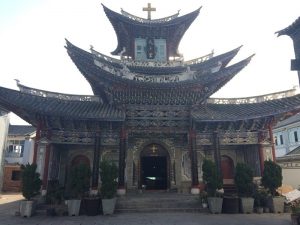
The Catholic Church of Dali Ancient Town is located in a quiet alley of Renmin Road, Dali Ancient Town. It was built in 1927. The official introduction of Catholicism to Yunnan was in the late Ming and early Qing dynasties. The architectural features of the church are unique, regarded as the national treasure that blends the characteristics of the local Bai culture with the Han and Western architecture, enjoying a flying arch and a beautiful painting. The Dali is Ancient Town is beautiful, quiet and charming. It has rich multi-ethnic culture and traditional Chinese Han culture, and the unique combination of Western culture. Catholic Church is the evidence of the integration of Chinese and Western culture.
Why is Catholic Church of Dali Ancient so special?
The Catholic Church shows the harmony of Chinese and Western culture. The church is the combination of the features of Bai, Han and Western architecture. In 1983, it was entitled as the “Relics Protection Unit” by the Dali Cultural Relics Department.
Where is Catholic Church?
The Catholic Church is in Dali Ancient Town, located at the north of Xiaguan Town, 13 kilometers away. This ancient city is situated between Cangshan Mountain and Erhai Lake.
Distance from other famous attractions in Dali
About 5 kilometers from Erhai Lake
About 2.3 kilometers from Three Pagodas of Dali
About 1.9 kilometers from Cangshan Mountain
About 24.7 kilometers from Shuanglang
How to Get to Catholic Church?
Travelers can use our private car taking to Dali Ancient Town from Dali Airport or Dali Railway Station at first. If you are independent travelers, you can take bus or go by taxi.
1.By Car
From Dali Airport: It is about 30 km from Dali Airport to Dali Ancient Town. There are airport shuttle running between the airport to Dali Old Town. The drive takes about 40 minutes. If by taxi, it may cost around 80~100 Yuan.
From Dali Railway Station: It is about 26 km from Dali Railway Station to Dali Ancient Town. Travelers can take No.8 bus outside of the railway station to Dali Ancient Town, which takes about 40 minutes. If by taxi, it may cost around 50 Yuan.
2.By Bus
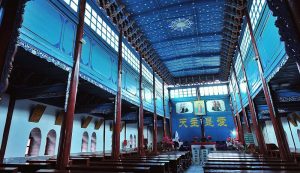
Taking bus No.4, No.8 in Xiaguan about 40 minutes to the Dali Ancient Town, the fare is 2 yuan. People who take bus No.8 can choose to get off at the east gate. In Yuer road there is touring bus passing Wind Flower Snow and Moon Hotel, Guozi Garden, Bluestone Bridge, Yeyu Road, Yuer Park, Boai Crossing and Cangshan Mountain Gate. In addition, visitors can take the minibus to Dali Ancient Town in Jianshe Road and Cultural Road, about 30 minutes to reach the old city. There are three options of transportation of electronic mobile, mountain bike and walk for tourists in Dali Ancient Town.
History of Cotholic Church
The official introduction of Catholicism into Yunnan was in the late Ming and early Qing dynasties. There were two main ways: First, the Queen, and the royal family members of the “Yongli Royal Family” in Nanming; second, some Tibetan members migrated to Sichuan. In the northeastern part of Yunnan, which is today’s northeastern part of Zhaotong, Yanjin County, and then Sichuan priests went from Yibin to Yunnan for pastoral visits and missionary work, which led to the further development of Catholicism in Yunnan.
In 1696, with the increasing number of church members, Yunnan established a pastoral area, but for various reasons, the two bishops did not take up their posts, so they were later merged into the Sichuan Diocese.
In 1840, the Yunnan Diocese was established again. The Bishop’s Office was set up in Longxi Village, Yanjin County, Zhaotong. Later, in 1876, it moved to Kunshan East Road to establish the Bishop’s Office. In 1936, it moved to its current address. With the continuous development of Catholicism in Yunnan, by 1946, Yunnan was divided into three parishes of Kunming, Dali and Zhaotong. The Dali diocese was established in 1929.
Architecture Feature
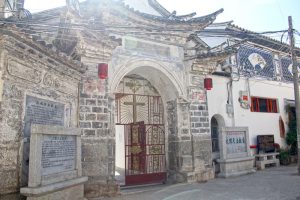
When we step into a narrow and quaint little street full of Bai architecture, we will see a quaint church that blends traditional Chinese and Bai architectural styles. Its church architecture is unique. It is famous for its unique style of architectural structure, exquisite carving art, and the blending of Chinese and Western architecture. At home and abroad, priests and tourists from all over the world come here to visit and visit.
According to the local old believers, the church was built in 1927. In 1983, with the support of the relevant government departments, the church was completely renovated. It was completed and opened at the end of the year. The church is a Bai temple style. The altar in the church is made of locally marble. The church is carved and painted inside and outside, and has a strong Bai architectural style. The “four-in-five patio” of the church’s annex building complements the main building of the church, echoing each other, and the flowers and trees are hidden among them, making the whole church more religious, quiet and full of vitality.
From the front, the church looks like a flying dragon, reflecting the strong traditional Chinese cultural thoughts – the descendants of dragon, Chinese; from the side, it looks like a huge ship, symbolizing the church as anchored by Noah’s Ark. Voyage brings hope, justice, peace and love to mankind. According to local people, the shape of the church is also taken from the Bible, Luke 8:22-25. Jesus calms the teachings and connotations of the storm. As long as there is love and peace, people can overcome difficulties.
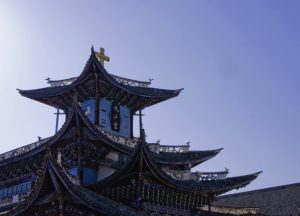
Walking into the church, it seems to have entered ancient galleries and museums. The northern walls are covered with ancient and excellent Western paintings. The south wall is inlaid with a beautiful Chinese landscape painting. The front three paintings and the middle one are churches. According to the introduction, there are more than 60 paintings on the entire church wall, which give us the wonderful enjoyment, endless reverie and thinking. Localization and situationalization are the best ways to spread and survive and develop. It is also the cause we are striving for and engaged in now.
Nearby Attractions
Dali Ancient Town is a historic town with rich culture located between Cangshan Mountain and Erhai Lake. Unlike any other Chinese town, the traditional Bai ethnic houses give the town distinctive feel. Travelers can wonder in this leisure town to appreciate the unique ethnic architecture and discover its profound history and culture.
The Three Pagodas,the symbolic building of Dali, was first built in the time of Nanzhao Kingdom and Dali Kingdom in 9th and 10th century. Looking from a distance, the pagodas are like three ballpoint pens standing between the magnificent Cangshan Mountain and elegant Erhai Lake.
Best Time to Visit
Dali Ancient Town is a very comfortable and leisure site which can be visited all year round. There is a saying going “Good Scenery is the month of March”. March to April is the best time to visit Dali Ancient City. If you want to enjoy Bai’s grand festival, you can come in the beautiful spring and catch the rare chance to join in March Fair.
Useful Travel Tips
1.Best Time to Visit
A lot of festivals and events of Bai nationality focused on March to April each year, travel at this time you will feel rich ethnic customs. And there is a song: “March in Dali has good scenery”, so in the spring, it is suitable whether it is traveling to Dali, or climbing Canshang Mountain, visiting Erhai Lake.
2. What to Pack
Dali belongs to the low altitude plateau monsoon climate and ultraviolet ray is strong. Travelers should bring usual clothes and necessities as well as sunscreen cream and sunglasses to protect yourselves.
Yuanyang Hani Rice Terraces in Yunnan
Why is Yuanyang Rice Terraces so special? Yuanyang Rice Terraces are the Hani ethnic minority’s masterpiece of ingenuity. In unique shapes and sizes with thousands of years of history, they...
Laohuzui Rice Terraces in Yuanyang County,Honghe
Introduction Laohuzui(Tiger Mouth)Rice Terraces scenic area mainly consists of Mengpin Village, Dongfu Village, Amengkong Village, Baoshan Village and etc. It got the name due to its shape. The zigzag...
Bada Rice Terraces in Yuanyang County, Honghe
Why Visit Bada Rice Terraces? Bada Rice Terraces, a part of Honghe Hani Rice Terraces, was listed as World Heritage Site in 2013. The 950-hectare Bada Rice Terraces is...
Qingkou Hani Rice Terraces in Yuanyang County, Honghe
Introduction Walk from Yuanyang Xinjie Town into Yuanyang Terraced Fields, Qingkou Rice Terraces is at the first sight. The viewing deck of Qingkou Rice Terraces is by the highway....
Duoyishu Rice Terraces in Yuanyang County,Honghe
Why Visit Duoyishu Rice Terraces? Duoyishu Rice Terraces, part of Honghe Hani Rice Terraces, was listed as World Heritage Site in 2013. This scenic area is the best site...
Three Parallel Rivers of Yunnan Protected Areas
Why is Three Parallel Rivers Natural Reserve So Special? Three Parallel Rivers Natural Reserve is a UNESCO World Heritage Site, a nature reserve extending over 170,000 km2 within the undulating...
Luchong Scenic Area of Fuxian Lake, Yuxi
Why is Luchong Scenic Area So Special? Luchong Scenic Area禄充景区 is located at the west bank of Fuxian Lake. There are beautiful Fuxian Lake, Bijia hill, Yusun hill玉笋山 and...
Fuxian Lake, Yuxi
Fuxian Lake Overview Located in Chengjiang county, which is 52 kilometers away from Kunming, Fuxian lake is 5 kilometers away from the county seat of Chengjiang county. It is...
Dashanbao Black-necked Crane Nature Reserve, Zhaotong
Why is Dashanbao Black-necked Crane Nature Reserve So Special? Dashanbao is one of the most popular destination for Yunnan Birding Tours. Covering a total area of 19,200 hectares, the Reserve...
Three Pagodas and Chongsheng Monastery, Dali
Chinese Name:大理崇圣寺三塔 English Name: Three Pagodas and Chongsheng Monastery, Dali An overview of The three pagodas The magnificent Chongsheng Temple and the well-known Three Pagodas are the symbol of Dali....
Songzanlin Monastery, Shangrila
Why is Songzanlin Monastery So Special? Built in 1679, the monastery is the largest Tibetan Buddhist temple complex in Yunnan province and one of the famous monasteries in the Kang region, which...
Catholic Church of Dali Old Town in Dali City
Catholic Church of Dali Ancient Town The Catholic Church of Dali Ancient Town is located in a quiet alley of Renmin Road, Dali Ancient Town. It was built in 1927....
Tips Before Travel
Bring copies of your passport
Don't assume you're restricted to the main hubs of Beijing and Shanghai, our tours can start from any city.
Register with your embassy
For your safety, please register with the Embassy.
Always have local cash
Exchange some local currency for your trip
Our Team
Customize a Trip
Start planning your tailor-made holiday to China by contacting one of our specialists. Once enquired, you’ll get a response within 0.5~23.5 hours.






















